വിഷസസ്യങ്ങളുടെ പട്ടിക
വിക്കിപീഡിയയുടെ ഗുണനിലവാരത്തിലും, മാനദണ്ഡത്തിലും എത്തിച്ചേരാൻ ഈ ലേഖനം വൃത്തിയാക്കി എടുക്കേണ്ടതുണ്ട്. ഈ ലേഖനത്തെക്കുറിച്ച് കൂടുതൽ വിശദീകരണങ്ങൾ നൽകാനാഗ്രഹിക്കുന്നെങ്കിൽ ദയവായി സംവാദം താൾ കാണുക. ലേഖനങ്ങളിൽ ഈ ഫലകം ചേർക്കുന്നവർ, ഈ താൾ വൃത്തിയാക്കാനുള്ള നിർദ്ദേശങ്ങൾ കൂടി ലേഖനത്തിന്റെ സംവാദത്താളിൽ പങ്കുവെക്കാൻ അഭ്യർത്ഥിക്കുന്നു. |

വിഷസസ്യങ്ങൾ വിഷാംശങ്ങൾ ഉൽപ്പാദിപ്പിക്കുന്ന സസ്യങ്ങളാണ്. സസ്യങ്ങളിൽ നിന്ന് രക്ഷപെടാൻ സസ്യങ്ങൾക്ക് സഞ്ചാര ശേഷിയില്ലാത്തതിനാൽ, അവ മൃഗങ്ങളിൽ നിന്ന് സ്വയം സംരക്ഷിക്കുന്നതിനുള്ള ഒരു മാർഗ്ഗമായിരിക്കണം ഇത്. ചില സസ്യങ്ങൾക്ക് മുള്ളുകൾ, മുൾപടർപ്പുകൾ തുടങ്ങിയ ശാരീരിക പ്രതിരോധങ്ങളുണ്ട്, പക്ഷേ ഏറ്റവും സാധാരണമായ തരം സംരക്ഷണം രാസപരമാണ്.[1] സഹസ്രാബ്ദങ്ങളായി, പ്രകൃതിനിർദ്ധാരണ പ്രക്രിയ വഴി, സസ്യ സംരക്ഷണത്തെ ഒഴിവാക്കാൻ, രാസ സംയുക്തങ്ങളുടെ വിശാലവും സങ്കീർണ്ണവുമായ ഒരു ശ്രേണി നിർമ്മിക്കാനുള്ള മാർഗ്ഗങ്ങൾ സസ്യങ്ങൾ രൂപപ്പെടുത്തിയിട്ടുണ്ട്. ഉദാഹരണത്തിന്, സസ്യങ്ങളുടെ പരിണാമ ചരിത്രത്തിൽ, ടാനിൻ താരതമ്യേന നേരെയുള്ള ഒരു പ്രതിരോധ സംയുക്തമാണ്. പോളി അസറ്റൈലീനുകൾ പോലെയുള്ള കൂടുതൽ സങ്കീർണ്ണമായ തന്മാത്രകൾ ആസ്റ്റെരേൽസ് പോലുള്ള ചെടികളിൽ കാണപ്പെടുന്നു. അറിയപ്പെടുന്ന സസ്യസംരക്ഷണ സംയുക്തങ്ങളിൽ പലതും പ്രാഥമികമായി പ്രാണികളുടെ ഉപഭോഗത്തെ പ്രതിരോധിക്കുന്നു, അത്തരം സസ്യങ്ങൾ കഴിക്കുന്ന മനുഷ്യരുൾപ്പെടെയുള്ള മറ്റ് മൃഗങ്ങൾ, മിതമായ അസുഖം മുതൽ മരണം വരെ, പ്രതികൂല ഫലങ്ങൾ ഉണ്ടാകുന്നു.
| പൊതുവായ പേര് | ശാസ്ത്രീയ നാമം | വിവരണം | ചിത്രം |
|---|---|---|---|
| ആപ്പിൾ | മാലസ് ഡൊമസ്റ്റിക്ക | വിത്തുകൾ രൂക്ഷമായ വിഷമുള്ളതാണ്, ചെറിയ അളവിൽ സയനോജനിക് ഗ്ലൈക്കോസൈഡ് ആയ അമിഗ്ഡലിൻ അടങ്ങിയിരിക്കുന്നു. അതിൽ അടങ്ങിയിരിക്കുന്ന അളവ് സാധാരണയായി മനുഷ്യർക്ക് അപകടകരമാകാൻ സാധ്യതയില്ല. എന്നാൽ ആവശ്യത്തിലധികം വിത്തുകൾ ഉപയോഗിച്ചാൽ ഒരു മാരകമായ അളവ് ആയി അപകടത്തിനു സാധ്യതയുണ്ട്. | 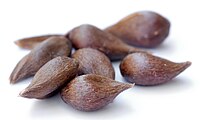
|
| ശതാവരിച്ചെടി | അസ്പരാഗസ് ഒഫിഷിനാലിസ് | അസ്പരാഗസ് ഒഫിഷിനാലിസ്, അസ്പരാഗസ് ഡെൻസിഫ്ലോറസ് തുടങ്ങിയ ഒട്ടേറെ സ്പീഷീസുകൾ ഇതിലുൾപ്പെട്ടിട്ടുണ്ട്. പ്രത്യുൽപാദന പക്വഫലം നേടുന്നതിന് മുമ്പ് ഭക്ഷണത്തിനായി കൃഷി ചെയ്യുന്ന ശതാവരി സസ്യങ്ങൾ സാധാരണയായി വിളവെടുക്കുന്നു. മുതിർന്നവർക്കുള്ള പ്ലാൻറിൻറെ സരസഫലങ്ങൾ വിഷം നിറഞ്ഞതാണ്, ഇതിൽ ഫുറോസ്റ്റനോൾ, സ്പിറോസ്റ്റനോൾ, സാപോനിൻ എന്നിവയും അടങ്ങിയിട്ടുണ്ട്.iഅഞ്ചു മുതൽ ഏഴ് കായ്കനികൾ കൂടുതലായി കഴിക്കുന്നത് വയറിലെ വേദനയും ഛർദ്ദിയും ഉളവാക്കാൻ കാരണമാകുന്നു. പ്ലാന്റ് കൈകാര്യം ചില ആളുകളിൽ. ഇളം തണ്ടുകളിലെ സൾഫർ സംയുക്തങ്ങൾ രൂക്ഷമായ ചർമ്മപ്രശ്നങ്ങൾക്ക് ഭാഗികമായെങ്കിലും കാരണമാകാറുണ്ടെന്ന് കരുതപ്പെടുന്നു. [2][3] | 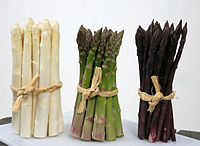
|
| കാസ്സവ | മാനിഹോട്ട് എസ്കുലെൻറ | വേരുകളിലും ഇലകളിലും രണ്ട് സയോജനിക് ഗ്ലൈക്കോസൈഡ്], ലിനമറിൻ, ലോട്ടസ്റ്റ്രാലിൻ എന്നിവ അടങ്ങിയിട്ടുണ്ട്. These are decomposed by linamarase, a naturally occurring enzyme in cassava, liberating hydrogen cyanide .[4] Cassava varieties are often categorized as either sweet or bitter, respectively signifying the absence or presence of toxic levels of cyanogenic glycosides. The 'sweet' cultivars can produce as little as 20 milligrams of cyanide per kilogram of fresh roots, whereas bitter ones may produce more than 50 times as much (1 g/kg). Cassavas grown during drought are especially high in these toxins.[5][6] A dose of 40 mg of pure cassava cyanogenic glycoside is sufficient to kill a cow. It can also cause severe calcific pancreatitis in humans, leading to chronic pancreatitis. Processing (soaking, cooking, fermentation, etc.) of cassava root is necessary to remove the toxins and avoid getting sick. In the tropics, where cassava farming is a major industry, "Chronic, low-level cyanide exposure is associated with the development of goiter and with tropical ataxic neuropathy, a nerve-damaging disorder that renders a person unsteady and uncoordinated. Severe cyanide poisoning, particularly during famines, is associated with outbreaks of a debilitating, irreversible paralytic disorder called konzo and, in some cases, death. The incidence of konzo and tropical ataxic neuropathy can be as high as 3 percent in some areas."[7] For some smaller-rooted sweet varieties, cooking is sufficient to eliminate all toxicity. The cyanide is carried away in the processing water and the amounts produced in domestic consumption are too small to have environmental impact.[4] The larger-rooted, bitter varieties used for production of flour or starch must be processed to remove the cyanogenic glycosides.[8] Industrial production of cassava flour, even at the cottage level, may generate enough cyanide and cyanogenic glycosides in the effluvia to have a severe environmental impact.[4] | |
| ചെറി | Prunus cerasus | As well as other Prunus species such as peach (Prunus persica), plum (Prunus domestica), almond (Prunus dulcis), and apricot (Prunus armeniaca). Leaves and seeds contain amygdalin, a cyanogenic glycoside. | 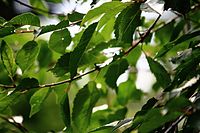
|
| മുന്തിരി | Vitis spp. | Potentially toxic to dogs, although the precise mechanism is not fully understood. See grape and raisin toxicity in dogs. | |
| ഇന്ത്യൻ നിലക്കടല | Lathyrus sativus | A legume grown in Asia and East Africa as an insurance crop for use during famines. Like other grain legumes, L. sativus produces a high-protein seed. The seeds contain variable amounts of β-N-Oxalyl-L-α,β-diaminopropionic acid or ODAP, a neurotoxic amino acid.[9] ODAP causes wasting and paralysis if eaten over a long period, and is considered the cause of the disease neurolathyrism, a neurodegenerative disease that causes paralysis of the lower body and emaciation of gluteal muscle (buttocks). The disease has been seen to occur after famines in Europe (France, Spain, Germany), North Africa and South Asia, and is still prevalent in Eritrea, Ethiopia and parts of Afghanistan when Lathyrus seed is the exclusive or main source of nutrients for extended periods. | |
| അമര പയർ or common bean | Phaseolus vulgaris | The toxic compound phytohaemagglutinin, a lectin, is present in many varieties of common bean but is especially concentrated in red kidney beans. The lectin has a number of effects on cell metabolism; it induces mitosis, and affects the cell membrane in regard to transport and permeability to proteins. It agglutinates most mammalian red blood cell types. Consumption of as few as four or five raw kidney beans may be sufficient to trigger symptoms, which include nausea, vomiting, and diarrhea. Onset is from 1 to 3 hours after consumption of improperly prepared beans, and symptoms typically resolve within a few hours.[10] Phytohaemagglutinin can be deactivated by cooking beans at 100 °C (212 °F) for ten minutes, which is required to degrade the toxin and is much shorter than the hours required to fully cook the beans themselves. For dry beans the U.S. Food and Drug Administration (FDA) also recommends an initial soak of at least 5 hours in water, after which the soaking water should be discarded.[10] However, lower cooking temperatures may have the paradoxical effect of potentiating the toxic effect of haemagglutinin. Beans cooked at 80 °C (176 °F) are reported to be up to five times as toxic as raw beans.[10] Outbreaks of poisoning have been associated with the use of slow cookers, the low cooking temperatures of which may be unable to degrade the toxin. | |
| ലിമ ബീൻ or ബട്ടർ ബീൻസ് | Phaseolus lunatus | Raw beans contain dangerous amounts of linamarin, a cyanogenic glycoside. | |
| ചെറുനാരങ്ങ | Citrus limon | As well as lime, orange and other citrus fruits are known to contain aromatic oils and compounds of Psoralen which is toxic to dogs, cats, and some animals. The acid is found all over the entire plant. Symptoms include vomiting, diarrhea, depression and photosensitivity. | 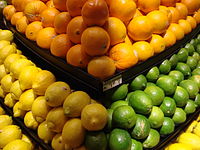
|
| മാവ് | Mangifera indica | Mango peel and sap contain urushiol, the allergen in poison ivy and poison sumac that can cause urushiol-induced contact dermatitis in susceptible people. Cross-reactions between mango contact allergens and urushiol have been observed. Those with a history of poison ivy or poison oak contact dermatitis may be most at risk for such an allergic reaction. Urushiol is also present in mango leaves and stems. During mango's primary ripening season, it is the most common source of plant dermatitis in Hawaii. | |
| ജാതിക്ക | Myristica fragrans | Contains myristicin, a naturally occurring insecticide and acaricide with possible neurotoxic effects on neuroblastoma cells.[11] It has psychoactive properties at doses much higher than used in cooking. Raw nutmeg produces anticholinergic-like symptoms, attributed to myristicin and elemicin.[12] The intoxicating effects of myristicin can lead to a physical state somewhere between waking and dreaming; euphoria is reported and nausea is often experienced. Users also report bloodshot eyes and memory disturbances.[13] Myristicin is also known to induce hallucinogenic effects, such as visual distortions. Nutmeg intoxication has an extremely long delay before peak is reached, sometimes taking up to seven hours, and effects can be felt for 24 hours, with lingering effects lasting up to 72 hours.[14][15] | |
| ഉള്ളി, വെളുത്തുള്ളി | Allium spp. | Many members of the genus Allium contain thiosulphate, which in high doses is toxic to dogs, cats and some types of livestock. Cats are more sensitive. | |
| ഉരുളക്കിഴങ്ങ് | Solanum tuberosum | Potatoes contain toxic compounds known as glycoalkaloids, of which the most prevalent are solanine and chaconine. Solanine is also found in other members of the Solanaceae plant family, which includes Atropa belladonna ("deadly nightshade") and Hyoscyamus niger ("henbane") (see entries below). The concentration of glycoalkaloid in wild potatoes is sufficient to produce toxic effects in humans. The toxin affects the nervous system, causing headaches, diarrhea and intense digestive disturbances, cramps, weakness and confusion, and in severe cases coma and death. Poisoning from cultivated potatoes occurs very rarely, however, as toxic compounds in the potato plant are generally concentrated in the green portions of the plant and in the fruits, and cultivated varieties contain smaller concentrations than wild plants.[16][17] Cooking at high temperatures (over 170 °C or 340 °F) also partly destroys the toxin. However, exposure to light, physical damage, and age can increase glycoalkaloid content within the tuber,[18] the highest concentrations occurring just underneath the skin. Tubers that are exposed to light turn green from chlorophyll synthesis, thus giving a visual clue as to areas of the tuber that may have become more toxic; however, this does not provide a definitive guide, as greening and glycoalkaloid accumulation can occur independently of each other. Some varieties of potato contain greater glycoalkaloid concentrations than others; breeders developing new varieties test for this, and sometimes have to discard an otherwise promising cultivar. Breeders try to keep solanine levels below 200 mg/kg (200 ppmw). However, when these commercial varieties turn green, even they can approach concentrations of solanine of 1000 mg/kg (1000 ppmw). The U.S. National Toxicology Program suggests that the average American consume no more than 12.5 mg/day of solanine from potatoes (the toxic dose is actually several times this, depending on body weight). | |
| റുബാർബ് | Rheum rhaponticum | The leaf stalks (petioles) are edible, but the leaves themselves contain notable quantities of oxalic acid, which is a nephrotoxic and corrosive acid present in many plants. Symptoms of poisoning include kidney disorders, convulsions and coma, though it is rarely fatal. The LD50 (median lethal dose) for pure oxalic acid in rats is about 375 mg/kg body weight,[19] or about 25 grams for a 65 kg (~140 lb) human. Although the oxalic acid content of rhubarb leaves can vary, a typical value is about 0.5%,[20] so almost 5 kg of the extremely sour leaves would have to be consumed to reach the LD50. Cooking the leaves with soda can make them more poisonous by producing soluble oxalates.[21] However, the leaves are believed to also contain an additional, unidentified toxin,[22] which might be an anthraquinone glycoside (also known as senna glycosides).[23] In the edible leaf stalks, the concentration of oxalic acid is much lower, contributing only about 2–2.5% of the total acidity, which is dominated by malic acid.[24] This means that even the raw stalks may not be hazardous (though they are generally thought to be in the US). However, the tart taste of the raw stalks is so strong as to be unpalatable to most consumers. | |
| തക്കാളി | Solanum lycopersicum | Like many other members of the nightshade family (Solanaceae), tomato leaves and stems contain solanine that is toxic if ingested, causing digestive upset and nervous excitement. Use of tomato leaves as an herbal tea (infusion) has been responsible for at least one death.[25] Leaves, stems, and green unripe fruit of the tomato plant also contain small amounts of the poisonous alkaloid tomatine,[26] although levels are generally too small to be dangerous.[26][27] Ripe tomatoes do not contain any detectable tomatine.[26] Tomato plants can be toxic to dogs if they eat large amounts of the fruit, or chew plant material.[28] | 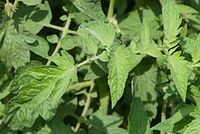
|
മറ്റ് വിഷമുള്ള സസ്യങ്ങൾ[തിരുത്തുക]
ഭക്ഷണമായി സാധാരണ ഉപയോഗിക്കാത്ത അസംഖ്യം സസ്യങ്ങൾ പോലും വിഷമുള്ളതാണ്, അവ അബദ്ധത്തിൽ എടുക്കുന്നതോ, കഴിക്കുന്നതോ ഒഴിവാക്കാൻ ശ്രദ്ധിക്കണം.:
| ശാസ്ത്രീയ നാമം | പൊതുവായ പേരുകൾ, വിവരണം | ചിത്രം |
|---|---|---|
| Abrus precatorius | Known commonly as jequirity, crab's eye, rosary pea, 'John Crow' bead, precatory bean, Indian licorice, akar saga, giddee giddee, jumbie bead, ruti, and weather plant. The attractive seeds (usually about the size of a ladybug, glossy red with one black dot) contain abrin, a ribosome-inactivating protein related to ricin, and very potent. Symptoms of poisoning include nausea, vomiting, convulsions, liver failure, and death, usually after several days. Ingesting a single seed can kill an adult human. The seeds have been used as beads in jewelry, which is dangerous; inhaled dust is toxic and pinpricks can be fatal. The seeds are unfortunately attractive to children. | 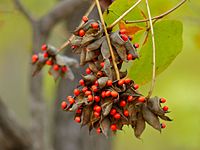
|
| Aconitum genus | Several species, commonly called aconite, wolfsbane and monkshood. All parts are poisonous. The poison is an alkaloid called aconitine, which disables nerves, lowers blood pressure, and can stop the heart. Even casual skin contact should be avoided; symptoms include numbness, tingling, and cardiac irregularity. It has been used as poison for bullets (by German forces during World War II), as a bait and arrow poison (ancient Greece), and to poison water supplies (reports from ancient Asia).[അവലംബം ആവശ്യമാണ്] If ingested, it usually causes burning, tingling, and numbness in the mouth, followed by vomiting and nervous excitement. It is usually a quick-acting poison, and has been used in the past for killing wolves (hence one of the common names). | 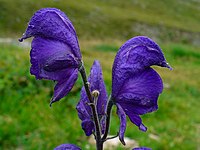
|
| Actaea pachypoda | Also known as doll's eyes or white baneberry. All parts are poisonous, especially the berries, the consumption of which has a sedative effect on cardiac muscle tissue and can cause cardiac arrest. | 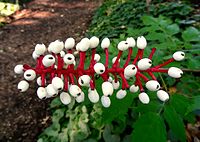
|
| Adenium obesum | Also known as sabi star, kudu or desert-rose. The plant exudes a highly toxic sap which is used by the Meridian High and Hadza in Tanzania to coat arrow-tips for hunting. | 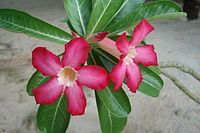
|
| Adonis vernalis | Known variously as pheasant's eye and false hellebore, the plant is poisonous, containing cardiostimulant compounds, such as adonidin and aconitic acid.[29] | 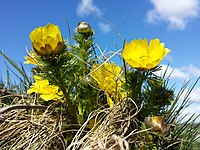
|
| Aesculus hippocastanum | Commonly known as horse-chestnut. All parts of the plant are poisonous, causing nausea, muscle twitches, and sometimes paralysis. | |
| Agave genus | The juice of a number of species causes acute contact dermatitis, with blistering lasting several weeks and recurring itching for several years thereafter. | |
| Ageratina altissima | Commonly known as white snakeroot. All parts are poisonous, causing nausea and vomiting. Often fatal. Milk from cattle that have eaten white snakeroot can sicken, or kill, humans (milk sickness). | 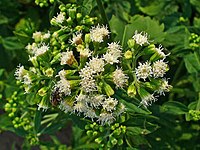
|
| Agrostemma githago | Commonly known as corn cockle. Contains the saponins githagin and agrostemmic acid. All parts of the plant are reported to be poisonous and may produce chronic or acute, potentially fatal poisoning, although it has been used in folk medicine to treat a range of ills, from parasites to cancer. There are no known recent clinical studies of corn cockle which provide a basis for dosage recommendations, however doses higher than 3 g (of seeds) are considered toxic.[30] | 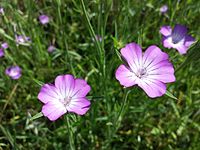
|
| Anemone nemorosa | Common names include wood anemone, windflower and thimbleweed. The plant contains poisonous chemicals that are toxic to animals including humans, but it has also been used as a medicine. All parts of the plant contain protoanemonin, which can cause severe skin and gastrointestinal irritation, bitter taste and burning in the mouth and throat, mouth ulcers, nausea, vomiting, diarrhea, and hematemesis.[31] | 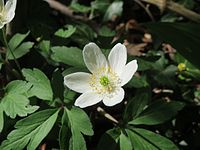
|
| Anthurium genus | Common names include anthurium, tailflower, flamingo flower. Anthurium plants are poisonous due to calcium oxalate crystals. The sap is irritating to the skin and eyes.[32] | 
|
| Aquilegia genus | Several species commonly known as columbine. Seeds and roots contain cardiogenic toxins which cause both severe gastroenteritis and heart palpitations if consumed. The flowers of various species were consumed in moderation by Native Americans as a condiment with other fresh greens, and are reported to be very sweet, and safe if consumed in small quantities. Native Americans also used very small amounts of the root as an effective treatment for ulcers. However, medical use of this plant is difficult due to its high toxicity; columbine poisonings are easily fatal.[33] | 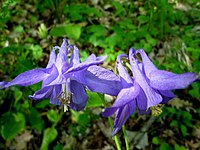
|
| Areca catechu | Commonly known as betel nut palm and pinyang. The nut contains an alkaloid related to nicotine which is addictive. It produces a mild high, some stimulation, and lots of red saliva, which cannot be swallowed as it causes nausea. Withdrawal causes headache and sweats. Use is correlated with mouth cancer, and to a lesser extent asthma and heart disease. | |
| Argemone mexicana | Common names include Mexican poppy, flowering thistle, cardo or cardosanto. A. mexicana seeds contain 22–36% of a pale yellow non-edible oil, called argemone oil or katkar oil, which contains the toxic alkaloids sanguinarine and dihydrosanguinarine. Katkar oil poisoning causes epidemic dropsy, with symptoms including extreme swelling, particularly of the legs. | 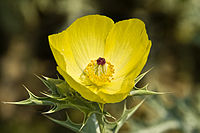
|
| Arnica montana | Also known as wolf's bane. It contains the toxin helenalin, which can be poisonous if large amounts of the plant are eaten or small amounts of concentrated Arnica are used. Consumption of A. montana can produce severe gastroenteritis, internal bleeding of the digestive tract, raised liver enzymes (which can indicate inflammation of the liver), nervousness, accelerated heart rate, muscular weakness, and death if enough is ingested.[34][35] Contact with the plant can also cause skin irritation.[36][37] In the Ames test, an extract of A. montana was found to be mutagenic.[35] The plant's toxicity has led to the USFDA officially declaring it to be an unsafe. | 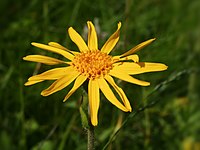
|
| Arum maculatum | Commonly known as cuckoo-pint, lords and ladies, jack-in-the-pulpit, wake robin, wild arum, devils and angels, cows and bulls, Adam and Eve, bobbins and starch-root. All parts of the plant can produce allergic reactions. The bright red berries contain oxalates of saponins and can cause skin, mouth and throat irritation, resulting in swelling, burning pain, breathing difficulties and stomach upset. One of the most common causes of plant poisoning. | 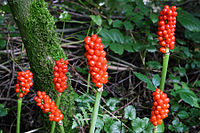
|
| Atropa belladonna | Commonly known as deadly nightshade, belladonna, devil's cherry and dwale, an Anglo-Saxon term meaning "stupifying drink"). One of the most toxic plants found in the Western hemisphere, all parts of the plant contain tropane alkaloids[38] – as do those of its equally deadly sister species A.baetica, A.pallidiflora and A.acuminata. The active agents are atropine, hyoscine (scopolamine), and hyoscyamine, which have anticholinergic properties.[39][40] The symptoms of poisoning include dilated pupils, sensitivity to light, blurred vision, tachycardia, loss of balance, staggering, headache, rash, flushing, dry mouth and throat, slurred speech, urinary retention, constipation, confusion, hallucinations, delirium, and convulsions.[39][41][42] The root of the plant is generally the most toxic part, though this can vary from one specimen to another. Ingestion of a single leaf of the plant can be fatal to an adult.[38] Casual contact with the leaves can cause skin pustules. The berries pose the greatest danger to children because they look attractive and have a somewhat sweet taste.[43] The consumption of two to five berries by children and ten to twenty berries by adults can be lethal. In 2009, a case of A. belladonna being mistaken for blueberries, with six berries ingested by an adult woman, was documented to result in severe anticholinergic syndrome.[44] The plant's deadly symptoms are caused by atropine's disruption of the parasympathetic nervous system's ability to regulate involuntary activities such as sweating, breathing, and heart rate. The antidote for atropine poisoning is physostigmine or pilocarpine.[45] A. belladonna is also toxic to many domestic animals, causing narcosis and paralysis.[46] However, cattle and rabbits eat the plant seemingly without any harmful effects.[42] In humans its anticholinergic properties will cause the disruption of cognitive capacities like memory and learning.[40] | 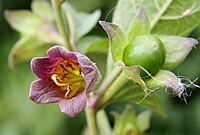
|
| Brugmansia genus | Commonly known as angel's trumpet. All parts of all plants in this genus contain the tropane alkaloids scopolamine and atropine; often fatal. These plants are closely related to and were once grouped with members of the genus Datura, which contain the same deadly alkaloids. Effects of ingestion may include losing connection with reality and hallucinations. An unfortunate case has been reported in the neuroscience literature, about a young man performing self-amputation with pruning shears after intentionally ingesting brugmansia tea, boiled from just two flowers.[47] | 
|
| Caladium genus | Commonly known as angel wings, elephant ear and heart of Jesus. All parts of all plants in this genus are poisonous. Symptoms are generally irritation, pain, and swelling of tissues. If the mouth or tongue swell, breathing may be fatally blocked. | 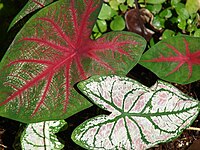
|
| Calla palustris | Also known as marsh calla, wild calla and water-arum. The plant is very poisonous when fresh due to its high oxalic acid content, but the rhizome (like that of Caladium, Colocasia, and Arum) is edible after drying, grinding, leaching and boiling.[48] | 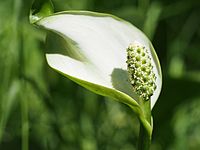
|
| Caltha palustris | Commonly known as marsh-marigold and kingcup. It contains several active substances of which the most important from a toxicological point of view is protoanemonin. Larger quantities of the plant may cause convulsions, burning of the throat, vomiting, bloody diarrhea, dizziness and fainting. Contact of the skin or mucous membranes with the juices can cause blistering or inflammation, and gastric illness if ingested. Younger parts seem to contain less toxics and heating breaks these substances down. Small amounts of Caltha in hay do not cause problems when fed to husbandry, but larger quantities lead to gastric illness.[49] | 
|
| Cascabela thevetia | Also known as yellow oleander. All parts of the plant are toxic to most vertebrates as they contain cardiac glycosides. Many cases of intentional and accidental poisoning of humans are known.[50] | 
|
| Cephalanthus occidentalis | Commonly called buttonbush. It has a number of historical medicinal uses, but it is also toxic due to the presence of cephalathin.[51] | 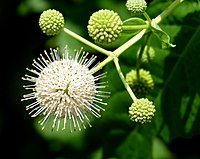
|
| Cerbera odollam | Commonly known as the suicide tree. The seeds contain cerberin, a potent toxin related to digoxin. The poison blocks the calcium ion channels in heart muscle, causing disruption of the heart beat. This is typically fatal and can result from ingesting a single seed. Cerberin is difficult to detect in autopsies and its taste can be masked with strong spices, such as a curry. It is often used in homicide and suicide in India; Kerala's suicide rate is about three times the Indian average. In 2004, a team led by Yvan Gaillard of the Laboratory of Analytical Toxicology in La Voulte-sur-Rhône, France, documented more than 500 cases of fatal Cerbera poisoning between 1989 and 1999 in Kerala. They said "To the best of our knowledge, no plant in the world is responsible for as many deaths by suicide as the odollam tree.'[52] A related species is Cerbera tanghin the seeds of which are known as tanghin poison nut and have been used as an 'ordeal poison'. | 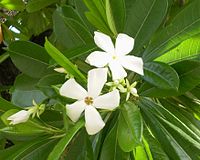
|
| Chelidonium majus | Also known as greater celandine. The whole plant is toxic in moderate doses as it contains a range of isoquinoline alkaloids, but there are claimed to be therapeutic uses when used at the correct dosage.[53] The main alkaloid present in the herb and root is coptisine, with berberine, chelidonine, sanguinarine and chelerythrine also present. Sanguinarine is particularly toxic with an LD50 of only 18 mg per kg body weight.[54] The effect of the fresh herb is analgesic, cholagogic, antimicrobial and oncostatic,[55] with action as a central nervous system sedative. In animal tests, Chelidonium majus is shown to be cytostatic. Early studies showed that the latex causes contact dermatitis and eye irritation. Stains on skin of the fingers are sometimes reported to cause eye irritation after rubbing the eyes or handling contact lenses. The characteristic latex also contains proteolytic enzymes and the phytocystatin chelidostatin, a cysteine protease inhibitor.[56] | 
|
| Cicuta genus | Commonly known as water hemlock, cowbane, wild carrot, snakeweed, poison parsnip, false parsley, children's bane and death-of-man. The root, when freshly pulled out of the ground, is extremely poisonous and contains the toxin cicutoxin, a central nervous system stimulant that induces seizures. When dried, the poisonous effect is reduced. The most common species is C. maculata; one of the species found in the Western USA, C. douglasii, often found in pastures and swamps, has especially thick stems and very large and sturdy flowers which are sometimes harvested for flower displays. This is inadvisable as the sap is also toxic. | 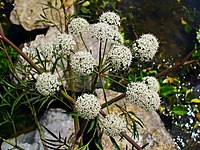
|
| Cleistanthus collinus | Ingestion of its leaves or a dicoction of its leaves causes hypokalemia (kaliuresis and cardiac arrhythmias),[57] metabolic acidosis, hypotension and hypoxia.[58] | 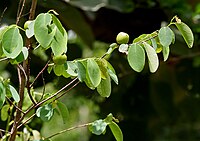
|
| Clivia miniata | Commonly known as Natal lily, bush lily and Kaffir lily. It contains small amounts of lycorine, making it poisonous. | 
|
| Codiaeum variegatum | Also known as garden croton or variegated croton. As with many of the Euphorbiaceae, the sap can cause skin eczema in some people. The bark, roots, latex, and leaves are poisonous.[59] | 
|
| Colchicum autumnale | Commonly known as autumn crocus and meadow saffron. The bulbs contain colchicine. Colchicine poisoning has been compared to arsenic poisoning; symptoms typically start 2 to 5 hours after a toxic dose has been ingested but may take up to 24 hours to appear, and include burning in the mouth and throat, fever, vomiting, diarrhea, abdominal pain and kidney failure. Onset of multiple-system organ failure may occur within 24 to 72 hours. This includes hypovolemic shock due to extreme vascular damage and fluid loss through the GI tract, which may result in death. Additionally, sufferers may experience kidney damage resulting in low urine output and bloody urine, low white blood cell counts (persisting for several days), anemia, muscular weakness, and respiratory failure. Recovery may begin within 6 to 8 days. There is no specific antidote for colchicine, although various treatments do exist.[60] Despite dosing issues concerning its toxicity, colchicine is prescribed in the treatment of gout,[61] familial Mediterranean fever, pericarditis and Behçet's disease. It is also being investigated for its use as an anti-cancer drug. | 
|
| Conium maculatum | Commonly known as hemlock, poison hemlock, spotted parsley, spotted cowbane, bad-man's oatmeal, poison snakeweed and beaver poison. All parts of the plant contain the alkaloid coniine which causes stomach pains, vomiting, and progressive paralysis of the central nervous system; can be fatal. Not to be confused with hemlock trees (Tsuga spp.), which, while not edible, are not nearly as toxic as the herbaceous plant. An infusion of poison hemlock is said to have killed Socrates in 399 BC. | 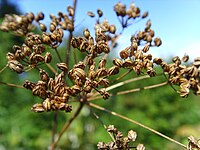
|
| Consolida subgenus | Commonly known as larkspur.[62] Young plants and seeds are poisonous, causing nausea, muscle twitches, and paralysis; often fatal. Other plants in the parent genus Delphinium are also poisonous and commonly called larkspur. | 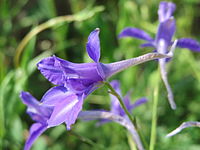
|
| Convallaria majalis | Commonly known as lily of the valley. Contains 38 different cardiac glycosides. | 
|
| Coriaria myrtifolia | Commonly known as redoul. A Mediterranean plant containing the toxin coriamyrtin, ingestion of which produces digestive, neurological and respiratory problems. The poisonous fruits superficially resemble blackberries and may mistakenly be eaten as such. Can be fatal in children. | 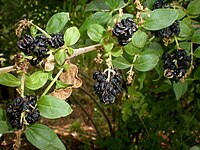
|
| Cytisus scoparius | Commonly known as broom or common broom. Contains toxic alkaloids that depress the heart and nervous system.[63] The alkaloid sparteine is a class 1a antiarrhythmic agent, a sodium channel blocker. It is not FDA approved for human use as an antiarrhythmic agent, and it is not included in the Vaughn Williams classification of antiarrhythmic drugs. | 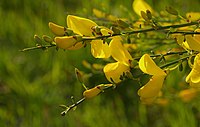
|
| Daphne genus | The berries (either red or yellow) are poisonous, causing burns to mouth and digestive tract, followed by coma; often fatal. | 
|
| Datura genus | Several species commonly known as jimson weed, thorn apple, stinkweed, Jamestown weed, angel's trumpets, moonflower, and sacred datura. Containing the tropane alkaloids scopolamine, hyoscyamine, and atropine, all parts of these plants are poisonous, especially the seeds and flowers. Ingestion causes abnormal thirst, hyperthermia, severe delirium and incoherence, visual distortions, bizarre and possibly violent behavior, memory loss, coma, and often death; it is a significant poison to grazing livestock in North America. Datura has been used as an entheogenic drug by the indigenous peoples of the Americas and others for centuries, though the extreme variability in a given plant's toxicity depending on its age and growing environment make such usage an exceptionally hazardous practice; the difference between a recreational dose and a lethal dose is minuscule,[64] and incorrect dosage often results in death. For this same reason, Datura has also been a popular poison for suicide and murder, particularly in parts of Europe and India. Reports of recreational usage are overwhelmingly negative; the majority of those who describe their use of Datura find their experiences extremely unpleasant and often physically dangerous.[65] | 
|
| Daucus carota | Commonly known as wild carrot. It can be dangerously toxic to humans.[66] Daucus carota has been reported to contain acetone, asarone, choline, ethanol, formic acid, HCN, isobutyric acid, limonene, malic acid, maltose, oxalic acid, palmitic acid, pyrrolidine, and quinic acid.[67] When in contact with wet Daucus carota, skin irritation and vesication may occur. | 
|
| Deathcamas | Various genera in the family Melanthieae have species whose common names include "deathcamas", including Amianthium, Anticlea, Stenanthium, Toxicoscordion and Zigadenus. All parts of these plants are toxic, due to the presence of alkaloids. Grazing animals, such as sheep and cattle, may be affected and human fatalities have occurred.[68] | 
|
| Delphinium genus | Also known as larkspur. Contains the alkaloid delsoline. Young plants and seeds are poisonous, causing nausea, muscle twitches, paralysis, and often death. | 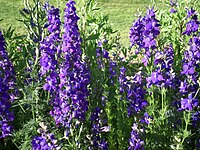
|
| Dendrocnide moroides | Known also as stinging tree and gympie gympie. Capable of inflicting a painful sting when touched. The stinging may last for several days and is exacerbated by touching, rubbing, and cold temperatures; can be fatal. | 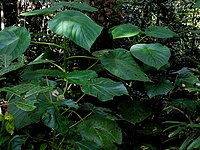
|
| Dicentra cucullaria | Also known as bleeding heart and Dutchman's breeches. Leaves and roots are poisonous and cause convulsions and other nervous symptoms. | 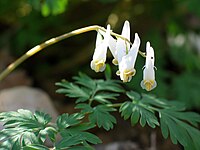
|
| Dichapetalum cymosum | Also known as gifblaar. Well known as a livestock poison in South Africa, this plant contains the metabolic poison fluoroacetic acid. | |
| Dieffenbachia genus | Commonly known as dumbcane. All parts are poisonous; the culprits are needle-shaped crystals of calcium oxalate called raphides, which can cause intense burning, reddening of the skin, irritation, and immobility of the tongue, mouth, and throat if ingested. Swelling can be severe enough to block breathing, leading to death, though this is rare; in most cases, symptoms are mild and can be successfully treated with basic analgesics, antihistamines, or charcoal. | 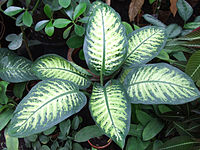
|
| Digitalis purpurea | Commonly known as foxglove. The leaves, seeds, and flowers are poisonous, containing cardiac or other steroid glycosides. These cause irregular heartbeat, general digestive upset, and confusion; can be fatal. | 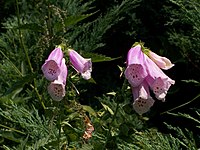
|
| Dioscorea communis | Also known as black bryony. All components of the plant, including the tubers, are poisonous due to saponin content, therefore it is not typically used internally. However, it has been used as a poultice for bruises and inflamed joints. It has been suggested that black bryony be used topically with caution, due to a tendency for the plant to cause painful blisters. Studies have isolated calcium oxalate deposits and histamines in the berry juice and rhizomes, which may contribute to skin irritation and contact dermatitis.[69] | 
|
| Duranta erecta | Common names include golden dewdrop, pigeon berry, and skyflower. The leaves and berries of the plant are toxic and are confirmed to have killed children, dogs and cats.[70] | 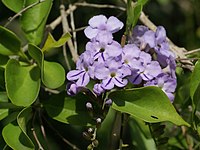
|
| Erysimum cheiri | Also known as wallflower. It contains constituents that may affect the heart.[71] | 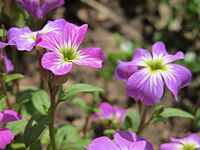
|
| Euonymus europaeus | Commonly known as spindle, European spindle or spindle tree. The fruit is poisonous, containing amongst other substances, the alkaloids theobromine and caffeine, as well as an extremely bitter terpene. Poisonings are more common in young children, who are enticed by the brightly coloured fruits. Ingestion can result in liver and kidney damage and even death. There are many other species of Euonymus, many of which are also poisonous. | 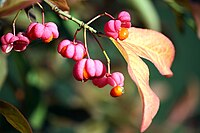
|
| Euphorbia pulcherrima | Known as poinsettia. Its latex can cause an allergic reaction in sensitive individuals.[72] It is also mildly irritating to the skin or stomach[73] and may sometimes cause diarrhea and vomiting if eaten.[74] Sap introduced into the human eye may cause temporary blindness.[75] | 
|
| Excoecaria agallocha | Commonly known as milky mangrove, blind-your-eye mangrove and river poison tree. Contact with latex can cause skin irritation and blistering; eye contact can cause temporary blindness. | 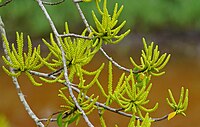
|
| Galanthus nivalis | Known as snowdrop. The plant contains an active lectin or agglutinin named GNA for Galanthus nivalis agglutinin, which is toxic. | 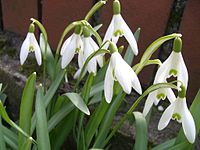
|
| Gelsemium sempervirens | Commonly known as yellow jessamine. All parts are poisonous, causing nausea and vomiting. Often fatal. It is possible to become ill from ingesting honey made from jessamine nectar. | 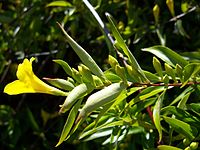
|
| Gloriosa superba | Common names include flame lily, climbing lily, gloriosa lily, and fire lily. The plant is poisonous, toxic enough to cause human and animal fatalities if ingested. Every part of the plant is poisonous, especially the tuberous rhizomes. As with other members of the Colchicaceae, this plant contains high levels of colchicine, a toxic alkaloid. It also contains the alkaloid gloriocine. Within a few hours of the ingestion of a toxic amount of plant material, a victim may experience nausea, vomiting, numbness, and tingling around the mouth, burning in the throat, abdominal pain, and bloody diarrhea. As the toxic syndrome progresses, rhabdomyolysis, ileus, respiratory depression, hypotension, coagulopathy, haematuria, altered mental status, seizures, coma, and ascending polyneuropathy may occur.[76] | 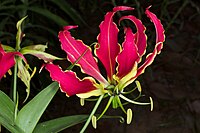
|
| Grevillea sp. | Commonly known as silky oak and spiderflower. A few species such as Grevillea 'Robyn Gordon', G. robusta, G. banksii, G. bipinnatifida and others can cause severe contact dermatitis.[77] | 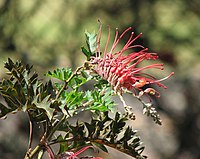
|
| Hedera helix | Also known as common ivy. The leaves and berries are poisonous, causing stomach pains, labored breathing, and possible coma. | 
|
| Heliotropium indicum | Commonly known as Indian heliotrope. It contains tumorigenic pyrrolizidine alkaloids.[78] | 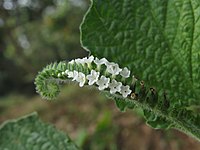
|
| Helleborus niger | Also known as Christmas rose. Contains protoanemonin,[79] or ranunculin,[80] which has an acrid taste and can cause burning of the eyes, mouth and throat, oral ulceration, gastroenteritis and hematemesis.[81] | 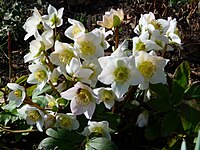
|
| Heracleum mantegazzianum | Also known as giant hogweed. The sap is phototoxic, causing phytophotodermatitis (severe skin inflammations) when affected skin is exposed to sunlight or to UV rays. Initially the skin becomes red and starts itching. Then blisters form as the reaction continues over 48 hours. They form black or purplish scars, which can last several years. Hospitalization may become necessary. | 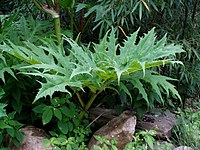
|
| Heracleum sosnowskyi | Commonly known as Sosnowsky's Hogweed. Plant has toxic sap and causes skin inflammation on contact. | 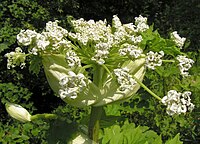
|
| Hippomane mancinella | Commonly known as manchineel. All parts of this tree, including the fruit, contain toxic phorbol esters typical of the Euphorbiaceae plant family. Specifically the tree contains 12-deoxy-5-hydroxyphorbol-6gamma, 7alpha-oxide, hippomanins, mancinellin, sapogenin, phloracetophenone-2, 4-dimethylether is present in the leaves, while the fruits possess physostigmine.[82] Contact with the milky white latex produces strong allergic dermatitis.[83] Standing beneath the tree during rain will cause blistering of the skin from even slight contact with this liquid (even a small drop of rain with the milky substance in it will cause the skin to blister). Burning tree parts may cause blindness if the smoke reaches the eyes. The fruit can also be fatal if eaten. Many trees carry a warning sign, while others have been marked with a red "X" on the trunk to indicate danger. In the French Antilles the trees are often marked with a painted red band a few feet above the ground.[84] The Caribs used the latex of this tree to poison their arrows and would tie captives to the trunk of the tree, ensuring a slow and painful death. A poultice of arrowroot (Maranta arundinacea) was used by the Arawaks and Taíno as an antidote against such arrow poisons.[85] The Caribs were also known to poison the water supply of their enemies with the leaves.[അവലംബം ആവശ്യമാണ്] Spanish explorer Juan Ponce de León was struck by an arrow that had been poisoned with manchineel sap during battle with the Calusa in Florida, dying shortly thereafter.[86] | 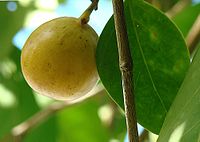
|
| Hyacinthus orientalis | Commonly known as hyacinth. The bulbs are poisonous, causing nausea, vomiting, gasping, convulsions, and possibly death. Even handling the bulbs can cause skin irritation. | |
| Hydrangea genus | Known commonly as hydrangea or hortensia. Hydrangeas are moderately toxic if eaten, with all parts of the plant containing cyanogenic glycosides.[87] | 
|
| Hyoscyamus niger | Commonly known as henbane. Seeds and foliage contain hyoscyamine, scopolamine and other tropane alkaloids. Can produce dilated pupils, hallucinations, increased heart rate, convulsions, vomiting, hypertension and ataxia. | 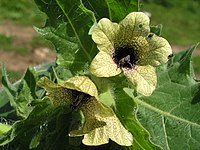
|
| Ilex aquifolium | Commonly known as European holly. The berries cause gastroenteritis, resulting in nausea, vomiting and diarrhea. | 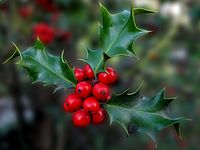
|
| Iris sibirica | Also known as Siberian iris or Siberian flag. Most parts of the plant are poisonous (rhizome and leaves), if mistakenly ingested can cause stomach pains and vomiting. Also handling the plant may cause a skin irritation or an allergic reaction.[88] | 
|
| Jacobaea vulgaris | Commonly known as ragwort. Contains many different alkaloids, including jacobine, jaconine, jacozine, otosenine, retrorsine, seneciphylline, senecionine, and senkirkine.[89] Poisonous to livestock and hence of concern to people who keep horses and cattle. Horses do not normally eat fresh ragwort due to its bitter taste, however it loses this taste when dried, and becomes dangerous in hay. The result, if sufficient quantity is consumed, can be irreversible cirrhosis of the liver. Signs that a horse has been poisoned include yellow mucus membranes, depression, and lack of coordination. The danger is that the toxin can have a cumulative effect; the alkaloid does not actually accumulate in the liver but a breakdown product can damage DNA and progressively kills cells. Jacobaea vulgaris is also theoretically poisonous to humans, although poisoning is unlikely as it is distasteful and not used as a food. However, some sensitive individuals can suffer from an allergic skin reaction after handling the plant because, like many members of the family Compositae, it contains sesquiterpine lactones (which are different from the pyrrolizidine alkaloids responsible for the toxic effects), which can cause compositae dermatitis. | 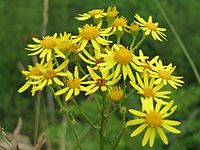
|
| Kalanchoe delagoensis | Commonly known as mother of millions. Contains bufadienolide cardiac glycosides[90] which can cause cardiac poisoning, particularly in grazing animals.[91] During 1997, 125 head of cattle died after eating mother-of-millions on a travelling stock reserve near Moree, New South Wales, Australia.[92] | 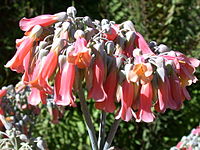
|
| Kalmia latifolia | Commonly known as mountain laurel. Contains andromedotoxin and arbutin. The green parts of the plant, flowers, twigs, and pollen are all toxic, and symptoms of toxicity begin to appear about 6 hours following ingestion. Poisoning produces anorexia, repeated swallowing, profuse salivation, depression, uncoordination, vomiting, frequent defecation, watering of the eyes, irregular or difficult breathing, weakness, cardiac distress, convulsions, coma, and eventually death. Autopsy will show gastrointestinal irritation and hemorrhage. | 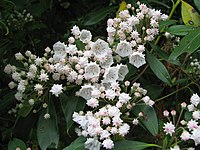
|
| Laburnum genus | Known as golden chain. All parts of the plant and especially the seeds are poisonous and can be lethal if consumed in excess. The main toxin is cytisine, a nicotinic receptor agonist. Symptoms of poisoning may include intense sleepiness, vomiting, excitement, staggering, convulsive movements, slight frothing at the mouth, unequally dilated pupils, coma and death. In some cases, diarrhea is very severe and at times the convulsions are markedly tetanic. | 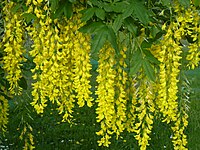
|
| Lamprocapnos spectabilis | Known commonly as bleeding heart. Contact with the plant can cause skin irritation in some people from isoquinoline-like alkaloids.[93] | 
|
| Lantana camara | Also known as big-sage, wild-sage, and tickberry. The toxicity of L. camara to humans is undetermined, with several studies suggesting that ingesting unripe berries can be toxic to humans.[94] Other studies have found evidence which suggests that ingestion of L. camara fruit poses no risk to humans and are in fact edible when ripe.[95] | 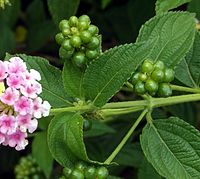
|
| Ligustrum genus | Several species, commonly known as privet. Berries and leaves are poisonous. Berries contain syringin, which causes digestive disturbances and nervous symptoms; can be fatal. Privet is one of several plants which are poisonous to horses. Privet pollen is known to cause asthma and eczema in sufferers. It is banned from sale or cultivation in New Zealand due to the effects of its pollen on asthma sufferers. | 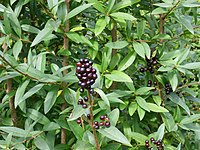
|
| Lilium genus | Commonly known as lily. Most have an unidentified water-soluble toxin found in all parts of the plant. Extremely poisonous, yet attractive, to cats, causing acute renal failure; as few as two petals of the flowers can kill. | 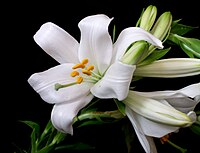
|
| Lolium temulentum | Commonly called darnel or poison ryegrass. The seeds and seed heads of this common garden weed may contain the alkaloids temuline and loliine. Some experts also point to the fungus ergot or fungi of the genus Endoconidium, both of which grow on the seed heads of rye grasses, as an additional source of toxicity.[96] | |
| Lupinus | Commonly known as lupin or lupine. Some varieties have edible seeds. Sweet lupines have less and bitter lupines more of the toxic alkaloids lupinine and sparteine. | 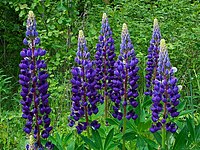
|
| Mandragora officinarum | Commonly called mandrake. | 
|
| Melia azedarach | Know commonly as Chinaberry tree, Cape lilac, and syringa berrytree. Fruits are poisonous to humans if eaten in quantity.[97] The toxins are neurotoxins and unidentified resins found mainly in the fruits. The first symptoms of poisoning appear a few hours after ingestion. They may include loss of appetite, vomiting, constipation or diarrhea, bloody faeces, stomach pain, pulmonary congestion, cardiac arrest, rigidity, lack of coordination and general weakness. Death may take place after about 24 hours. | 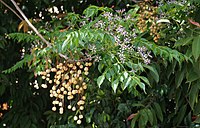
|
| Melianthus major | Also called honeybush. All parts of the plant are toxic. | 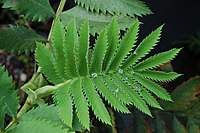
|
| Menispermum genus | Commonly known as moonseed. The fruits and seeds are poisonous, causing nausea and vomiting; often fatal. | |
| Mentha pulegium | Known commonly as pennyroyal or pennyrile. It is toxic to humans and has differing effects dependent on the volume and concentration ingested. The most concentrated and toxic form of the pennyroyal plant is pennyroyal oil. The oil contains 80% to 92% of cyclohexanone pulegone. Pulegone is the molecule in highest concentration, causes a variety of ailments in those who ingest it and is what causes the plant to have its peppermint flavor.[98] Symptoms that may persist after ingesting a small dose (<10 mL) of pennyroyal oil are nausea, vomiting, abdominal pain and dizziness. Larger volumes may result in multiorgan failure that could lead to death. | 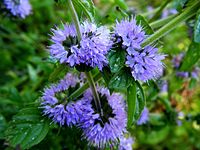
|
| Narcissus genus | Various species and garden cultivars commonly known as daffodil. The bulbs are poisonous and cause nausea, vomiting, and diarrhea; can be fatal. Stems also cause headaches, vomiting, and blurred vision. | 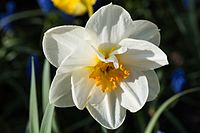
|
| Nerium oleander | Commonly known as oleander. All parts are toxic, the leaves and woody stems in particular. Contains nerioside, oleandroside, saponins and cardiac glycosides. Causes severe digestive upset, heart trouble and contact dermatitis. The smoke of burning oleander can cause reactions in the lungs, and can be fatal. | 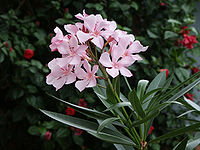
|
| Nicandra physalodes | Also known as apple-of-Peru and shoo-fly plant. The whole plant is said to be toxic (according to some sources, very toxic)[99] and to be used medicinally as a diuretic, sedative and cough medicine. | 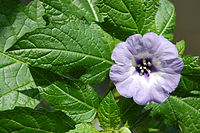
|
| Nicotiana glauca | Known commonly as tree tobacco. It contains the toxic alkaloid anabasine. Ingestion of the leaves can be fatal.[100] | 
|
| Oenanthe crocata | Commonly known as hemlock water dropwort. Contains oenanthotoxin. The leaves may be eaten safely by livestock, but the stems and especially the carbohydrate-rich roots are much more poisonous. Animals familiar with eating the leaves may eat the roots when these are exposed during ditch clearance – one root is sufficient to kill a cow, and human fatalities are also known in these circumstances. Scientists at the University of Eastern Piedmont in Italy claimed to have identified this as the plant responsible for producing the sardonic grin,[101][102] and it is the most-likely candidate for the "sardonic herb," which was a neurotoxic plant used for the ritual killing of elderly people in Phoenician Sardinia. When these people were unable to support themselves, they were intoxicated with this herb and then dropped from a high rock or beaten to death. Criminals were also executed in this way.[103] | 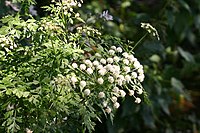
|
| Paris quadrifolia | Commonly known as herb-paris. Each plant only produces one blueberry-like berry, which is poisonous, as are other tissues of the plant.[104] Paris quadrifolia poisonings are rare, because the plant's solitary berry and its repulsive taste make it difficult to mistake it for a blueberry. | 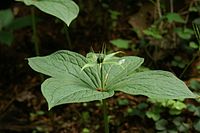
|
| Passiflora caerulea | Also known as the blue passion flower or the common passion flower. The leaves contain cyanogenic glycoside, which breaks down into cyanide. | 
|
| Peucedanum galbanum | Commonly known as blister bush. All parts are poisonous, and contact causes painful blistering that is intensified with exposure to sunlight. | 
|
| Phoradendron genus | Commonly known as American mistletoe; see also the related genus Viscum). Mistletoe is a common hemiparasite of trees and shrubs. Toxicity varies by species, but all parts of the plant, especially the leaves and berries, contain an array of dangerous chemicals, including proteins called phoratoxins and toxic alkaloids. Symptoms are very similar to those produced by Viscum species and may include acute gastrointestinal discomfort, diarrhea, weak pulse and/or slow heart rate, and even seizures; it is rarely lethal to adult humans, however, and many wild animals are adapted to eating its fruit. | 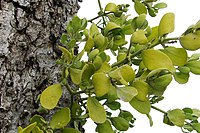
|
| Physostigma venenosum | Commonly known as calabar bean and also as ordeal beans due to their former use in trials by ordeal). The toxin in the seeds is the parasympathomimetic alkaloid physostigmine, a reversible cholinesterase inhibitor. Symptoms of poisoning include copious saliva, nausea, vomiting, diarrhea, anorexia, dizziness, headache, stomach pain, sweating, dyspepsia and seizures.,[105] and can lead to cholinergic syndrome or "SLUDGE syndrome". Medicinal uses of physostigmine include the treatment of myasthenia gravis, glaucoma, Alzheimer's disease and delayed gastric emptying. | |
| Phytolacca genus | Commonly known as pokeweed. Leaves, berries and roots contain phytolaccatoxin and phytolaccigenin. The toxicity of young leaves can be reduced with repeated boiling and draining. Ingestion of poisonous parts of the plant may cause severe stomach cramping, persistent diarrhea, nausea, vomiting (sometimes bloody), slow and difficult breathing, weakness, spasms, hypertension, severe convulsions, and death. | 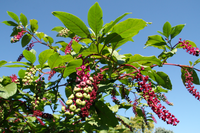
|
| Phytolacca americana | Known commonly as pokeweed. All parts of the plant are toxic and pose risks to human and mammalian health. The poisonous principles are found in highest concentrations in the rootstock, then in leaves and stems and then in the ripe fruit. The plant generally gets more toxic with maturity, with the exception of the berries (which have significant toxicity even while green).[106] | 
|
| Pieris japonica | Also known as Japanese pieris. The plant is poisonous if consumed by people or animals.[107] | 
|
| Plumeria genus | Commonly known as frangipani. Contact with the milky latex may irritate eyes and skin. | 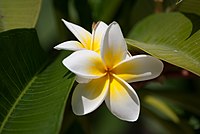
|
| Podophyllum peltatum | Commonly known as mayapple. Green portions of the plant, unripe fruit, and especially the rhizome contain the non-alkaloid toxin podophyllotoxin, which causes diarrhea and severe digestive upset. | 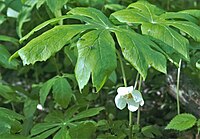
|
| Prunus laurocerasus | Also known as cherry laurel, common laurel, and sometimes English laurel. Leaves, fruit and seed may cause severe discomfort to humans if ingested.[108] The seeds contained within the cherries are poisonous like the rest of the plant, containing cyanogenic glycosides and amygdalin.[109] This chemical composition is what gives the smell of almonds when the leaves are crushed. Laurel water, a distillation made from the plant, contains prussic acid and other compounds and is toxic. | 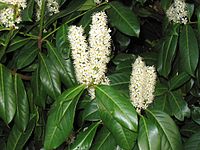
|
| Prunus padus | Known as bird cherry, hackberry, or Mayday tree. The glycosides prulaurasin and amygdalin, which can be poisonous, are present in some parts of P. padus, including the leaves, stems and fruits.[110] | 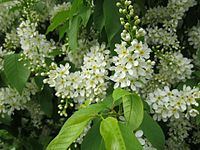
|
| Pteridium aquilinum | Commonly known as bracken. Carcinogenic to humans and animals such as mice, rats, horses and cattle when ingested. The carcinogenic compound is ptaquiloside or PTQ, which can leach from the plant into the water supply, which may explain an increase in the incidence of gastric and oesophageal cancers in humans in bracken-rich areas.[111] | 
|
| Pulsatilla cernua | Common names include pasque flower, wind flower, prairie crocus, meadow anemone. It is highly toxic, and produces cardiogenic toxins and oxytoxins which slow the heart in humans. Excess use can lead to diarrhea, vomiting and convulsions,[112] hypotension and coma.[113] | 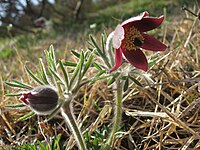
|
| Quercus genus | Several species, commonly known as oak. The leaves and acorns of oak species are poisonous in large amounts to humans and livestock, including cattle, horses, sheep and goats, but not pigs. Poisoning is caused by the toxin tannic acid, which causes gastroenteritis, heart trouble, contact dermatitis and kidney damage. Symptoms of poisoning include lack of appetite, depression, constipation, diarrhea (which may contain blood), blood in urine, and colic; it is rarely fatal, however, and in fact after proper processing acorns are consumed as a staple food in many parts of the world. | 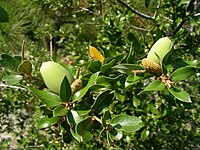
|
| Rhamnus cathartica | Commonly called buckthorn. The seeds and leaves are mildly poisonous for people and animals, but are readily eaten by birds.[114] | 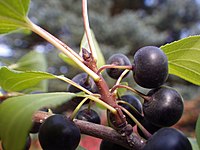
|
| Rhododendron genus | Several species including those known as azalea. All parts are poisonous and cause nausea, vomiting, depression, breathing difficulties, and coma, though it is rarely fatal. The primary source of toxicity is a group of closely related compounds called grayanotoxins, which block sodium ion channels in cellular membranes and prevent electrical repolarization during action potentials. Honey made from the nectar of Rhododendron plants may contain dangerous concentrations of grayanotoxins, and has been historically used as a poison and in alcoholic drinks. | 
|
| Rhododendron ferrugineum | Commonly called alpenrose, snow-rose or rusty-leaved alpenrose. It is moderately toxic, containing arbutin, arecoline and rhodoxanthin, and can cause vomiting, and difficulties of the digestive, nervous, respiratory and circulatory systems.[115] | 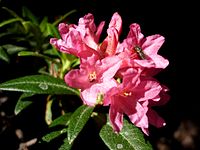
|
| Rhododendron luteum | Also known as yellow azalea or honeysuckle azalea. Despite the sweet perfume of the flowers, the nectar is toxic, containing grayanotoxin; records of poisoning of people eating the honey date back to the 4th century BC in Classical Greece. | 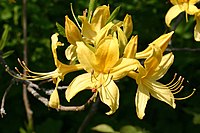
|
| Rhododendron tomentosum | Commonly known as marsh Labrador tea or wild rosemary. All parts of the plant contain poisonous terpenes that affect the central nervous system. First symptoms of overdose are dizziness and disturbances in movement, followed by spasms, nausea, and unconsciousness. The mere smell of the plant may cause headache to some people. | 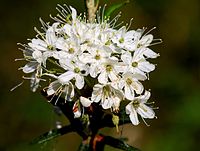
|
| Rhus genus | Certain species commonly known as African sumac. Formerly grouped with poison ivy and the rest of the Toxicodendron genus, all parts of this tree contain low levels of a highly irritating oil with urushiol. Skin reactions can include blisters and rashes. The oil spreads readily to clothes and back again, and has a very long life. Infections can follow scratching. As urushiol is not a poison but an allergen, it will not affect certain people. The smoke of burning Rhus lancia can cause reactions in the lungs, and can be fatal. | |
| Ricinus communis | Commonly known as castor oil plant, castor bean and Palma Christi. The seeds contain ricin, an extremely toxic and water-soluble ribosome-inactivating protein; it is also present in lower concentrations in other parts of the plant. Also present are ricinine, an alkaloid, and an irritant oil. According to the 2007 edition of the Guinness Book of World Records, the castor oil plant is the most poisonous in the world, though its cousin abrin, found in the seeds of the jequirity plant, is arguably more lethal. Castor oil, long used as a laxative, muscle rub, and in cosmetics, is made from the seeds, but the ricin protein is denatured during processing. Ricin irreversibly inhibits the ribosome, the molecular machine responsible for producing proteins in cells.[116] The LD50 in adults is only about 22 μg/kg when injected or inhaled; ingested ricin is much less toxic due to the digestive activity of peptidases, although a dose of 20 to 30 mg/kg, or about 4 to 8 seeds, can still cause death via this route. Reports of actual poisoning are relatively rare.[117] If ingested, symptoms may be delayed by up to 36 hours but commonly begin within 2–4 hours. These include a burning sensation in the mouth and throat, abdominal pain, purging and bloody diarrhea. Within several days there is severe dehydration, a drop in blood pressure and a decrease in urine. Unless treated, death can be expected to occur within 3–5 days; if victims have not succumbed after this time, they often recover.[118] Toxicity varies among animal species: 4 seeds will kill a rabbit, 5 a sheep, 6 an ox or horse, 7 a pig, and 11 a dog. Poisoning occurs when animals ingest broken seeds or break the seed by chewing; intact seeds may pass through the digestive tract without releasing the toxin. Ducks have shown substantial resistance to the seeds: it takes an average of 80 to kill them.[119] It was famously used to assassinate Bulgarian dissident Georgi Markov in 1978. | 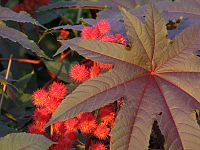
|
| Robinia genus | Also known as black locust and false acacia. All species produce toxic lectins.[120] The poison is a complex mix of lectins with the highest concentration in the fruit and seed, followed by the root bark and the flower. There is little poison in the leaf.[121] The lectins, generally called robin are less toxic than those of e.g. Abrus (abrin) or Ricinus (ricin), and in non-fatal cases the toxic effects tend to be temporary.[122] | 
|
| Sambucus genus | Commonly known as elder or elderberry. The roots, twigs, leaves, and unripe fruit are considered poisonous and cause nausea and digestive upset. Ripe berries must be cooked before consumption. | 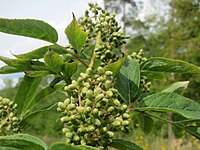
|
| Sanguinaria canadensis | Commonly known as bloodroot. The rhizome contains morphine-like benzylisoquinoline alkaloids, primarily the toxin sanguinarine. Sanguinarine kills animal cells by blocking the action of Na+/K+-ATPase transmembrane proteins. As a result, applying S. canadensis to the skin may destroy tissue and lead to the formation of a large scab, called an eschar. Although applying escharotic agents, including S. canadensis, to the skin is sometimes suggested as a home treatment for skin cancer, these attempts can be severely disfiguring,[123] as well as unsuccessful. Case reports have shown that in such instances tumor has recurred and/or metastasized.[124] The United States Food and Drug Administration (FDA) has approved the inclusion of sanguinarine in toothpastes as an antibacterial or anti-plaque agent,[125][126][127][128] although it is believed that this use may cause leukoplakia, a premalignant oral lesion.[129] The safe level of sanguinarine in such products is subject to regulation and debate.[130][131] S. canadensis extracts have also been promoted by some supplement companies as a treatment or cure for cancer, but the FDA has listed some of these products among its "187 Fake Cancer 'Cures' Consumers Should Avoid".[132] Bloodroot is a popular red natural dye used by Native American artists, especially among southeastern rivercane basketmakers.[133] However, in spite of supposed curative properties and historical use by Native Americans as an emetic, due to its toxicity internal use is not advisable (sanguinarine has an LD50 of only 18 mg per kg body weight).[54] | 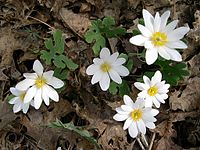
|
| Scopolia carniolica | Known as European scopolia or henbane bell. Its toxicity derives from its high levels of tropane alkaloids, particularly atropine. The quantity of atropine is the highest in the root. | 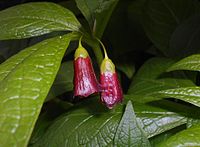
|
| Solanum dulcamara | Commonly known as bittersweet nightshade. All parts are poisonous, containing solanine and causing fatigue, paralysis, convulsions, and diarrhea. Rarely fatal.[134] | 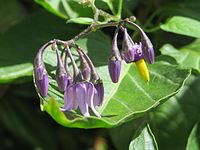
|
| Solanum nigrum | Commonly known as black nightshade. All parts of the plant except the ripe fruit contain the toxic glycoalkaloid solanine. Solanine poisoning is primarily displayed by gastrointestinal and neurological disorders. Symptoms include nausea, diarrhea, vomiting, stomach cramps, burning of the throat, cardiac dysrhythmia, headache and dizziness. In more severe cases, hallucinations, loss of sensation, paralysis, fever, jaundice, dilated pupils and hypothermia can result. In large quantities, solanine poisoning can be fatal. | 
|
| Solanum pseudocapsicum | Commonly known as Jerusalem cherry, Madeira winter cherry and winter cherry. All parts, especially the berries, are poisonous, causing nausea and vomiting. It is occasionally fatal, especially to children. | 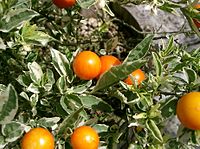
|
| Sophora secundiflora | Commonly known as mescal bean and Texas mountain laurel. | 
|
| Strophanthus gratus | The ripe seeds of this African plant contain ouabain, a potent cardiac glycoside that, when sufficiently concentrated, can induce cardiac arrest by binding to and inhibiting the action of the sodium-potassium pump and thereby drastically slowing the contraction of cardiac muscle cells. It was once used medicinally in small doses to treat congestive heart failure and other heart conditions, but has largely been replaced by the structurally related digoxin. Extracts from Strophanthus gratus and the bark of Acokanthera species have long been used by Somali tribesmen to poison hunting arrows; if the concentration is high enough, an arrow poisoned with ouabain can kill an adult hippopotamus. | 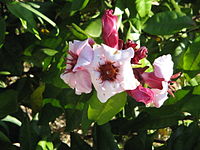
|
| Strychnos nux-vomica | Commonly known as the strychnine tree. The seeds usually contain about 1.5% strychnine, an extremely bitter and deadly alkaloid. This substance throws a human into intense muscle convulsions and usually kills within three hours. The bark of the tree may also contain brucine, another dangerous chemical. | 
|
| Taxus baccata | Commonly known as English yew, common yew and graveyard tree. Nearly all parts contain toxic taxanes (except the red, fleshy, and slightly sweet aril surrounding the toxic seeds).[135][136] The seeds themselves are particularly toxic if chewed.[137] Several people have committed suicide by ingesting leaves and seeds, including Catuvolcus, king of a tribe in what is now Belgium. | 
|
| Toxicodendron genus | Several species, including Toxicodendron radicans commonly known as poison ivy, Toxicodendron diversilobum commonly known as poison-oak, and Toxicodendron vernix commonly known as poison sumac. All parts of these plants contain a highly irritating oil with urushiol. Skin reactions can include blisters and rashes. The oil spreads readily to clothes and back again, and has a very long life. Infections can follow scratching. Despite the common names, urushiol is actually not a poison but an allergen, and because of this it will not affect certain people. The smoke of burning poison ivy can cause reactions in the lungs, and can be fatal. The allergic reaction caused by contact with poison ivy afflicts more than 70% of the human population, with as many as 350,000 cases reported annually in the United States alone | 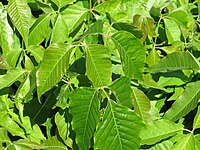
|
| Urtica ferox | Commonly known as ongaonga. Even the lightest touch can result in a painful sting that lasts several days. | 
|
| Veratrum genus | Commonly known as false hellebore and corn lily. Several species, containing highly toxic steroidal alkaloids (e.g. veratridine) that activate sodium ion channels and cause rapid cardiac failure and death if ingested.[138] All parts of the plant are poisonous, with the root and rhizomes being the most toxic.[138] Symptoms typically occur between 30 minutes and 4 hours after ingestion and include nausea and vomiting, abdominal pain, numbness, headache, sweating, muscle weakness, bradycardia, hypotension, cardiac arrhythmia, and seizures.[138] Treatment for poisoning includes gastrointestinal decontamination with activated charcoal followed by supportive care including fluid replacement, antiemetics for persistent nausea and vomiting, atropine for treatment of bradycardia, and vasopressors for the treatment of hypotension.[138] Native Americans used the juice pressed from the roots to poison arrows before combat. The dried powdered root of this plant was also used as an insecticide.[112] The plants' teratogenic properties and ability to induce severe birth defects were well known to Native Americans,[112] although they also used minute amounts of the winter-harvested root (combined with Salvia dorii to potentiate its effects and reduce the toxicity of the herb) to treat cancerous tumors. The toxic steroidal alkaloids are produced only when the plants are in active growth, so herbalists and Native Americans who used this plant for medicinal purposes harvested the roots during the winter months when the levels of toxic constituents were at their lowest. The roots of V. nigrum and V. schindleri have been used in Chinese herbalism (where plants of this genus are known as "li lu" (藜蘆). Li lu is used internally as a powerful emetic of last resort, and topically to kill external parasites, treat tinea and scabies, and stop itching.[139] However some herbalists refuse to prescribe li lu internally, citing the extreme difficulty in preparing a safe and effective dosage, and that death has occurred at a dosage of 0.6 grams.[139] During the 1930s Veratrum extracts were investigated in the treatment of high blood pressure in humans. However patients often suffered side effects due to the narrow therapeutic index of these products. Due to its toxicity, the use of Veratrum as a treatment for high blood pressure in humans was discontinued.[138] | 
|
| Vernicia fordii | Known as the tung tree. It is poisonous in all of its parts, including the fruit and the seeds, although some parts of the tree have been used for medicinal purposes in the past. According to one university website, just one seed from the fruit can be fatal, and other symptoms may include vomiting, diarrhea, and slowed breathing. The leaves can also give a rash similar to that from poison ivy.[140] | 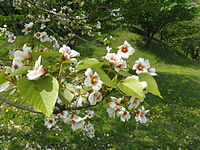
|
| Viscum genus | Commonly known as European mistletoe; see also the related genus Phoradendron). Mistletoe is a common hemiparasite of trees and shrubs. Toxicity varies by species, but all parts of the plant, especially the leaves and berries, contain an array of toxic chemicals, including several different viscotoxins, the alkaloid tyramine, and a ribosome-inactivating lectin called viscumin. Symptoms may include acute gastrointestinal discomfort, diarrhea, weak pulse and/or slow heart rate, and even seizures; it is rarely lethal to adult humans, however, and many wild animals are adapted to eating its fruit.[141][142] | 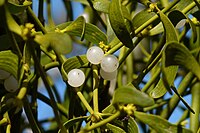
|
| Voacanga africana | The bark and seeds of this tropical tree contain a complex mixture of iboga alkaloids, including voacangine and voacamine. These compounds have been variously used as stimulants, psychedelic drugs, and poisons. | |
| Wisteria sinensis | Also known as Chinese wisteria. All parts of the plant contain a glycoside called wisterin which is toxic if ingested and may cause nausea, vomiting, stomach pains, and diarrhea. Wisterias have caused poisoning in children of many countries, producing mild to severe gastroenteritis. | 
|
| Xanthium genus | നിരവധി ഇനങ്ങൾ പൊതുവായി കോക്കിൾബർ എന്നറിയപ്പെടുന്നു. വടക്കേ അമേരിക്കൻ തദ്ദേശീയ സസ്യമായ കോമൺ കൊക്കിൾബർ (ക്സാന്തിയം സ്ട്രമാരിയം) കുതിര, കന്നുകാലികൾ, ആടുകൾ പോലെയുള്ള വളർത്തുമൃഗങ്ങൾക്ക് വിഷകരമാണ്. മറ്റു തീറ്റകൾ സുലഭമാണെങ്കിൽ ചില വളർത്തുമൃഗങ്ങൾ ഇതു ഭക്ഷിക്കുന്നത് ഒഴിവാക്കുന്നു. എന്നാൽ വിവേചനബുദ്ധി കുറവുള്ള പന്നി പോലെയുള്ള മൃഗങ്ങൾ ഇവ ആഹരിക്കുകയും രോഗം ബാധിച്ചു ചാകുകയും ചെയ്യുന്നു. മുളച്ച തൈകളും വിത്തുകളുമാണ് ഈ സസ്യങ്ങളുടെ ഏറ്റവും വിഷമയമായ ഭാഗങ്ങൾ. സാധാരണഗതിയിൽ രോഗലക്ഷണങ്ങൾ ഏതാനും മണിക്കൂറുകൾക്കുള്ളിൽത്തന്നെ പ്രത്യക്ഷപ്പെടുന്നതാണ്. ഉറയ്ക്കാത്ത ചുവടുകൾ, ബലഹീനത മന്ദത, മനംപിരട്ടൽ, ഛർദ്ദി, കഴുത്തിലെ പേശികളുടെ കോടൽ, ദ്രുതഗതിയിലുള്ളതും ദുർബലവുമായ നാഡീസ്പന്ദനം, ശ്വസിക്കാനുള്ള ബുദ്ധിമുട്ട് തുടങ്ങിയ ലക്ഷണങ്ങൾ കാണിക്കുകയും അന്തിമമായി ഇര മരണമടയുകയും ചെയ്യുന്നു. ക്സാന്തിയം അതിലെ ഔഷധഗുണങ്ങൾക്കായും മഞ്ഞവർണ്ണവസ്തു ഉണ്ടാക്കാനും ഉപയോഗിക്കുന്നു (ഗ്രീക്ക് ‘ക്സാന്തോസ്’ = മഞ്ഞ). | 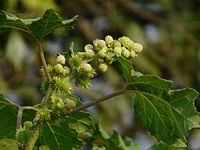
|
| Zantedeschia aethiopica | കല്ലാ ലിലി അഥവാ ആരം ലിലി എന്നറിയപ്പെടുന്നു. ചെടിയുടെ എല്ലാ ഭാഗങ്ങളും കാത്സ്യം ഓക്സാലേറ്റ് അടങ്ങിയതിനാൽ വിഷമയമാണ്. ഇത് വായിലും തൊണ്ടയിലും അസ്വസ്ഥതയും വീക്കവുമുണ്ടാക്കുന്നതൊടൊപ്പം അകമ്പടിയായി തീവ്രമായ ഛർദ്ദിയുടെയും വയറിളക്കവുമുണ്ടാക്കുന്നു. പ്രകോപനവും വാതവും ഉയർത്തുന്നു.[143] വിനാശകാരിയായ ചെടിയാണ്. | 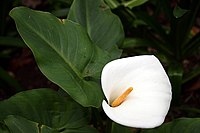
|
| Zigadenus glaberrimus | പൊതുവേ ഡെത്ത് കാമാസ് എന്നറിയപ്പെടുന്നു. സിഗാഡെനസ് ഗ്ലാബെറിമസിൻറെ ഏതാണ്ടെല്ലാ ഭാഗങ്ങളുംതന്നെ ആൽക്കലോയിഡുകളുടെ ആധിക്യത്താൽ വിഷലിപ്തതമായതാണ്. ഈ ഇനം അല്ലെങ്കിൽ ബന്ധപ്പെട്ട ഇനം മനുഷ്യന് പ്രാണഹാനിയുണ്ടാക്കാം.[144] |
ഇതും കാണുക[തിരുത്തുക]
- Biopesticide
- List of plants poisonous to equines
- List of poisonous fungi
- Mushroom poisoning
- Poison
- Psychedelic plants
- Secondary metabolite
- Toxin
- Weed
അവലംബം[തിരുത്തുക]
- ↑ Keddy, P.A. 2007. Plants and Vegetation: Origins, Processes, Consequences. Cambridge University Press, Cambridge, UK. 666 p. Chapter 7.
- ↑ "Growing Asparagus". gardengrow.co.nz. Retrieved 10 December 2010.
- ↑ "Poisonous Asparagus". asparagus-friends.com. Archived from the original on 2020-11-12. Retrieved 7 February 2015.
- ↑ 4.0 4.1 4.2 Cereda, M. P.; Mattos, M. C. Y. (1996). "Linamarin: the Toxic Compound of Cassava". Journal of Venomous Animals and Toxins. 2. doi:10.1590/S0104-79301996000100002.
- ↑ Aregheore EM, Agunbiade OO (1991). "The toxic effects of cassava (manihot esculenta grantz) diets on humans: a review". Vet. Hum. Toxicol. 33 (3): 274–275. PMID 1650055.
- ↑ White WL, Arias-Garzon DI, McMahon JM, Sayre RT (1998). "Cyanogenesis in Cassava : The Role of Hydroxynitrile Lyase in Root Cyanide Production". Plant Physiol. 116 (4): 1219–1225. doi:10.1104/pp.116.4.1219. PMC 35028. PMID 9536038.
- ↑ Wagner, Holly. "CASSAVA'S CYANIDE-PRODUCING ABILITIES CAN CAUSE NEUROPATHY…". Retrieved 21 June 2010.
- ↑ Padmaja G (1995). "Cyanide detoxification in cassava for food and feed uses". Critical Reviews in Food Science and Nutrition. 35 (4): 299–339. doi:10.1080/10408399509527703. PMID 7576161.
- ↑ "The Isolation and Characterization of β-N-Oxalyl-L-α,β-diaminopropionic acid: A Neurotoxin from the Seeds of Lathyrus sativus". Biochemistry. 3: 432–6. 1964. doi:10.1021/bi00891a022. PMID 14155110.
{{cite journal}}: Cite uses deprecated parameter|authors=(help) - ↑ 10.0 10.1 10.2 "Foodborne Pathogenic Microorganisms and Natural Toxins Handbook: Phytohaemagglutinin". Bad Bug Book. United States Food and Drug Administration. Retrieved 11 July 2009.
- ↑ Lee BK, Kim JH, Jung JW, Choi JW, Han ES, Lee SH, Ko KH, Ryu JH (2005). "Myristicin-induced neurotoxicity in human neuroblastoma SK-N-SH cells". Toxicol. Lett. 157 (1): 49–56. doi:10.1016/j.toxlet.2005.01.012. PMID 15795093.
- ↑ McKenna A, Nordt SP, Ryan J (August 2004). "Acute nutmeg poisoning". European Journal of Emergency Medicine. 11 (4): 240–1. doi:10.1097/01.mej.0000127649.69328.a5. PMID 15249817.
- ↑ See Erowid: Nutmeg for various primary and secondary sources related to nutmeg/myristicin intoxication.
- ↑ "Erowid Nutmeg Vault: Basics". www.erowid.org.
- ↑ "Erowid Experience Vaults: Nutmeg (also Myristica fragrans) Main Index". www.erowid.org.
- ↑ "Tomato-like Fruit on Potato Plants". Iowa State University. Archived from the original on 2004-07-16. Retrieved 8 January 2009.
- ↑ Glycoalkaloid and calystegine contents of eight potato cultivarsJ-Agric-Food-Chem. 2003 May 7; 51(10): 2964–73 Archived 11 February 2009 at the Wayback Machine.
- ↑ "Greening of potatoes". Food Science Australia. 2005. Archived from the original on 24 February 1999. Retrieved 15 November 2008.
- ↑ "Rhurbarb poisoning on rhurbabinfo.com". Archived from the original on 2008-10-16. Retrieved 2019-06-03.
- ↑ GW Pucher, AJ Wakeman, HB Vickery. "THE ORGANIC ACIDS OF RHUBARB (RHEUM HYBRIDUM). III. THE BEHAVIOR OF THE ORGANIC ACIDS DURING CULTURE OF EXCISED LEAVES Archived 2008-10-29 at the Wayback Machine.". Journal of Biological Chemistry, 1938
- ↑ Everist, Selwyn L., Poisonous Plants of Australia. Angus and Robertson, Melbourne, 1974, p. 583
- ↑ "Rhubarb leaves poisoning". Medline Plus Medical Encyclopedia.
- ↑ "Canadian Poisonous Plants Information System". Cbif.gc.ca. 1 September 2009. Archived from the original on 22 January 2009. Retrieved 5 March 2010.
- ↑ McGee, Harold. On Food and Cooking: The Science and Lore of the Kitchen. New York, NY: Scribner, 2004. p. 367
- ↑ Pittenger, Dennis R. (2002). "Vegetables That Contain Natural Toxins". California Master Gardener Handbook. ANR Publications. pp. 643–4. ISBN 978-1-879906-54-9.
{{cite book}}:|access-date=requires|url=(help); External link in|chapterurl=|chapterurl=ignored (|chapter-url=suggested) (help) - ↑ 26.0 26.1 26.2 Barceloux DG (June 2009). "Potatoes, Tomatoes, and Solanine Toxicity (Solanum tuberosum L., Solanum lycopersicum L.)". Disease-a-Month. 55 (6): 391–402. doi:10.1016/j.disamonth.2009.03.009. PMID 19446683.
- ↑ Mcgee, Harold (29 July 2009). "Accused, Yes, but Probably Not a Killer". The New York Times. ISSN 0362-4331. Retrieved 26 March 2010.
- ↑ Hound health handbook: the definitive guide to keeping your dog happy By Betsy Brevitz page 404
- ↑ "King's American Dispensatory: Adonis". Retrieved 17 April 2006.
- ↑ "Corn Cockle professional information from". Drugs.com. Retrieved 19 February 2013.
- ↑ Symptoms of Plant poisoning – Protoanemonin. RightDiagnosis.com
- ↑ Anthurium spp. Archived 3 October 2013 at the Wayback Machine. Poisonous Plants of North Carolina. North Carolina State University.
- ↑ Tilford, Gregory L. (1997): Edible and Medicinal Plants of the West. Mountain Press Pub., Missoula, Montana. ISBN 0-87842-359-1
- ↑ Gregory L. Tilford (1997). Edible and Medicinal Plants of the West. Mountain Press. ISBN 0-87842-359-1.
- ↑ 35.0 35.1 "Final report on the safety assessment of Arnica montana extract and Arnica montana". International Journal of Toxicology. 20 Suppl 2: 1–11. 2001. PMID 11558636.
- ↑ "Poisonous Plants: Arnica montana". North Carolina State University. Archived from the original on 17 ഒക്ടോബർ 2013. Retrieved 6 ജൂൺ 2014.
- ↑ Rudzki E; Grzywa Z (October 1977). "Dermatitis from Arnica montana". Contact Dermatitis. 3 (5): 281–2. doi:10.1111/j.1600-0536.1977.tb03682.x. PMID 145351.
- ↑ 38.0 38.1 "Committee for Veterinary Medicinal Products, Atropa Belladonna, Summary Report" (PDF). The European Agency for the Evaluation of Medicinal Products. 1998. Archived from the original (PDF) on 18 July 2006. Retrieved 8 July 2008.
- ↑ 39.0 39.1 "Belladonna". Medline Plus. 16 December 2009. Retrieved 29 November 2010.
- ↑ 40.0 40.1 Giancarlo Pepeu; Maria Grazia Giovannini (2004). "Acetylcholine: I. Muscarinic Receptors". In Gernot Riedel; Bettina Platt (eds.). From messengers to molecules: memories are made of these (illustrated ed.). Springer. ISBN 978-0-306-47862-8.
- ↑ Mallinson T (2010). "Deadly Nightshade: Atropa Belladonna". Focus on First Aid (15): 5. Archived from the original on 21 May 2010.
- ↑ 42.0 42.1 Lee MR (March 2007). "Solanaceae IV: Atropa belladonna, deadly nightshade" (PDF). J R Coll Physicians Edinb. 37 (1): 77–84. PMID 17575737.
- ↑ Grieve, Margaret; Leyel C.F (1971). Modern Herbal. Courier Dover Publications. p. 584. ISBN 0-486-22799-5. Retrieved 8 July 2008.
- ↑ Mateo Montoya A, Mavrakanas N, Schutz JS (2009). "Acute anticholinergic syndrome from Atropa belladonna mistaken for blueberries". Eur J Ophthalmol. 19 (1): 170–2. PMID 19123171.
- ↑ Potter, Samuel O.L. (1893). A Handbook of Materia Medica Pharmacy and Therapeutics. London: P. Blakiston's. p. 53.
- ↑ North Carolina State University Department of Plant Biology (2000). "Poisonous Vascular Plants". NC State University. Retrieved 7 July 2008.
- ↑ "Effects of toxic plants commonly found in home gardens". Fantastic Gardeners.
- ↑ A Dictionary of Flowering Plants and Ferns – JC Willis
- ↑ "Caltha palustris". Native Plant Database. Lady Bird Johnson Wildflower Center.
- ↑ Shannon D. Langford; Paul J. Boor (1996). "Oleander toxicity: an examination of human and animal toxic exposures". Toxicology. 109 (1): 1–13. doi:10.1016/0300-483X(95)03296-R. PMID 8619248.
{{cite journal}}: Unknown parameter|last-author-amp=ignored (|name-list-style=suggested) (help) - ↑ "Common Buttonbush Cephalanthus occidentalis L." (PDF). Natural Resources Conservation Service Plant Guide. United States Department of Agriculture.
- ↑ "'Suicide tree' toxin is 'perfect' murder weapon – 26 November 2004 – New Scientist". Newscientist.com. 26 November 2004. Retrieved 19 February 2013.
- ↑ Gruenwald, Joerg (2000). PDR for Herbal Medicines. Thomson PDR. ISBN 1-56363-361-2.
- ↑ 54.0 54.1 Golob, Peter; Caroline Moss; Melanie Dales; Alex Fidgen; Jenny Evans; Irene Gudrups (1999). The use of spices and medicinals as bioactive protectants for grains. FAO Agricultural Services Bulletin. Vol. 137. Rome: Food and Agriculture Organization. ISBN 92-5-104294-2. Retrieved 17 July 2008.
- ↑ "Monographs". Naturalstandard.com. Retrieved 16 June 2009.
- ↑ Rogelj B, Popovic T, Ritonja A, Strukelj B, Brzin J (November 1998). "Chelidocystatin, a novel phytocystatin from Chelidonium majus". Phytochemistry. 49 (6): 1645–9. doi:10.1016/S0031-9422(98)00281-7. PMID 9862139.
- ↑ Thomas, K; Dayal, AK; Narasimhan, Alka G; Seshadri, MS; Cherian, AM; Kanakasabapathi, Molly B (1991). "Metabolic and Cardiac effects of Cleistanthus Collinus poisoning". J Assoc Physicians India. 39 (4): 312–314.
- ↑ Subrahmanyam, DK; Mooney, T; Raveendran, R; Zachariah, B. A (Nov 2003). "Clinical and laboratory profile of Cleistanthus collinus poisoning". J Assoc Physicians India. 51: 1052–4.
- ↑ National Tropical Botanical Garden Codiaeum variegatum (Euphorbiaceae) Archived 19 July 2011 at the Wayback Machine.
- ↑ Colchicine. National Institute for Occupational Safety and Health. Emergency Response Safety and Health Database, 22 August 2008. Retrieved 23 December 2008.
- ↑ "Colchicine for acute gout: updated information about dosing and drug interactions". National Prescribing Service. 14 May 2010. Archived from the original on 2012-06-30. Retrieved 14 May 2010.
- ↑ "Royal Horticultural Society". Archived from the original on 15 August 2004.
- ↑ Pojar, Jim, A. MacKinnon, and Paul B. Alaback. Plants of the Pacific Northwest Coast: Washington, Oregon, British Columbia & Alaska. Redmond, WA: Lone Pine Pub., 1994.
- ↑ "Erowid Datura Vault". Erowid.org. Retrieved 19 February 2013.
- ↑ Freye, E. (2010). "Toxicity of Datura Stramonium". Pharmacology and Abuse of Cocaine, Amphetamines, Ecstasy and Related Designer Drugs. Netherlands: Springer. pp. 217–218. doi:10.1007/978-90-481-2448-0_34. ISBN 978-90-481-2447-3.[പ്രവർത്തിക്കാത്ത കണ്ണി]
- ↑ "Daucus carota". plants.ces.ncsu.edu (in ഇംഗ്ലീഷ്). Retrieved 2017-03-31.
- ↑ "Daucus carota". www.hort.purdue.edu. Retrieved 2017-04-21.
- ↑ Schwartz, Fayla C. "Zigadenus glaberrimus". Flora of North America. Retrieved 26 April 2012., in Flora of North Americaial Committee, ed. (1982). Flora of North America. Retrieved 26 April 2012.
- ↑ "Black bryony (Tamus communis, Dioscorea communis) - Mango's Market". www.mangosmarket.com.
- ↑ Thompson, N (2007). "Poisonous Plants in Australia: Enabling consumers to buy safe plants" (PDF). WWF-Australia: 10. Archived from the original (PDF) on 2014-01-10. Retrieved 2008-12-11.
{{cite journal}}: Cite journal requires|journal=(help) - ↑ "Wallflower". WebMD.
- ↑ "Latex Allergy? Beware Poinsettias". WebMD. Retrieved January 28, 2010.
- ↑ Bender, Steve, ed. (January 2004). "Euphorbia". The Southern Living Garden Book (2nd ed.). Birmingham, Alabama: Oxmoor House. p. 306. ISBN 0-376-03910-8.
- ↑ "Are Poinsettia Plants Poisonous? Fact or Fiction?". Retrieved December 21, 2007.
- ↑ "Complete Poinsettia information from Drugs.com". Drugs.com. Retrieved November 29, 2008.
- ↑ Lal, H. S. and P. K. Mishra. (2011). Gloriosa superba – an endangered plant spotted for the first time from forest of Tpchanchi, Hazaribag (Jharkhand) India.[പ്രവർത്തിക്കാത്ത കണ്ണി] Science Research Reporter 1(2) 61-64.
- ↑ Menz, Jennifer; Rossi, Ric; Taylor, Wal C.; Wall, Leon (1 August 1986). "Contact dermatitis from Grevillea'Robyn Gordon'". Contact Dermatitis. 15 (3): 126–131. doi:10.1111/j.1600-0536.1986.tb01311.x – via Wiley Online Library.
- ↑ Fu, P.P., Yang, Y.C., Xia, Q., Chou, M.C., Cui, Y.Y., Lin G., "Pyrrolizidine alkaloids-tumorigenic components in Chinese herbal medicina and dietary supplements", Jornal of Food and Drug Analysis, Vol. 10, No. 4, 2002, pp. 198-211
- ↑ Olson, Kent R., Poisoning & Drug Overdose, p312 at Google Book Search, accessed 12 January 2009
- ↑ Smolinske, Susan C., Toxicity of Houseplants, pp38, 153 at Google Book Search, accessed 12 January 2009
- ↑ Olson, Kent R, Poisoning & Drug Overdose, p309 at Google Book Search, accessed 12 January 2009
- ↑ "Hippomane mancinella". Dr. Duke's Phytochemical and Ethnobotanical Databases. United States Department of Agriculture. Archived from the original on 10 November 2004. Retrieved 27 January 2009.
- ↑ Poisonous plants and animals of Florida and the Caribbean By David W. Nellis
- ↑ fr:Hippomane mancinella
- ↑ Jones, David E (2007). Poison Arrows: North American Indian Hunting and Warfare. University of Texas Press. p. 29. ISBN 978-0-292-71428-1. Retrieved 23 January 2009.
- ↑ Grunwald, Michael (2007). "Chapter 2: The Intruders". The Swamp. Simon & Schuster. p. 25. ISBN 978-0-7432-5107-5.
- ↑ "Hills of Snow".
- ↑ "Iris sibirica (Siberian iris)". kew.org. Archived from the original on 2014-11-05. Retrieved 3 January 2015.
- ↑ "(EHC 80, section 9.1.4)". Inchem.org. Retrieved 19 February 2013.
- ↑ Bryotoxins A, B and C: McKenzie et al. (1987), Steyn & van Heerden (1998)
- ↑ McKenzie & Dunster (1986), McKenzie et al. (1987)
- ↑ les tanner. "North West Weeds". Northwestweeds.nsw.gov.au. Archived from the original on 13 ഫെബ്രുവരി 2013. Retrieved 19 ഫെബ്രുവരി 2013.
- ↑ Leikin, Edited by Jerrold B.; Paloucek, Frank P. (2007), Poisoning and toxicology handbook, Boca Raton, Fla: CRC, p. 886, ISBN 1-4200-4479-6
{{citation}}:|first1=has generic name (help) - ↑ Sharma O. P. (2007). "A review of the hepatotoxic plant Lantana camara". Critical Reviews in Toxicology. 37: 313–352. doi:10.1080/10408440601177863. PMID 17453937.
- ↑ Herzog et al. (1996), Coppens d'Eeckenbrugge & Libreros Ferla (2000), TAMREC (2000)
- ↑ GENUS: Lolium Archived 2 May 2007 at the Wayback Machine.
- ↑ Russell et al. (1997)
- ↑ Siano, F; Catalfamo, M; Cautela, D; Servillo, L; Castaldo, D (2005). "Analysis of pulegone and its enanthiomeric distribution in mint-flavoured food products". Food Additives & Contaminants. 22 (3): 197–203.
- ↑ Polunin, Oleg Wild Flowers of Europe, pub. Oxford University Press 1969, pps. 370-371.
- ↑ Foster, Steven (2002). Western Medicinal Plants and Herbs. Boston, NY: Houghton Mifflin Company. p. 339. ISBN 0-395-83806-1.
- ↑ News Scan Briefs: Killer Smile, Scientific American, August 2009
- ↑ Appendino G, Pollastro F, Verotta L, Ballero M, Romano A, Wyrembek P, Szczuraszek K, Mozrzymas JW, Taglialatela-Scafati O (2009). "Polyacetylenes from Sardinian Oenanthe fistulosa: A Molecular Clue to risus sardonicus". Journal of Natural Products. 72 (5): 962–965. doi:10.1021/np8007717. PMC 2685611. PMID 19245244.
- ↑ Owen, James (2 June 2009). "Ancient Death-Smile Potion Decoded?". National Geographic News. Retrieved 18 October 2009.
- ↑ Jacquemyn, Hans; Brys, Rein; Hutchings, Michael J. (July 2008), "Biological Flora of the British Isles: Paris quadrifolia L.", Journal of Ecology, 96 (4): 833–844, doi:10.1111/j.1365-2745.2008.01397.x
- ↑ "Alzheimer Research Forum". Alzforum.org. 19 October 2008. Retrieved 19 February 2013.
- ↑ Amitava Dasgupta, 2011, Effects of Herbal Supplements on Clinical Laboratory Test Results, Volume 2, Patient Safety, Walter de Gruyter, ISBN 3-11-024562-0, see [1], accessed 2 May 2015.
- ↑ Smith, M. C. (1978). "Japanese pieris poisoning in the goat". Journal of the American Veterinary Medical Association. 173 (1): 78–79. PMID 670056.
- ↑ RHS A-Z encyclopedia of garden plants. United Kingdom: Dorling Kindersley. 2008. p. 1136. ISBN 1-4053-3296-4.
- ↑ "Gardening – North Carolina Cooperative Extension". www.ces.ncsu.edu. Archived from the original on 19 ഏപ്രിൽ 2007. Retrieved 31 മാർച്ച് 2007.
- ↑ "Prunus Padus (bird cherry) poisoning in cattle". Veterinary Record. 138: 188. 1996. doi:10.1136/vr.138.8.188.
…stems, leaves and fruits of P. padus contain the glycosides prulaurasin and amygdalin…
{{cite journal}}: Cite uses deprecated parameter|authors=(help) - ↑ Kate Ravilious (9 September 2004). "newspaper article on ptaquiloside from bracken entering water supplies". Guardian. Retrieved 19 February 2013.
- ↑ 112.0 112.1 112.2 Edible and Medicinal plants of the West, Gregory L. Tilford, ISBN 0-87842-359-1
- ↑ Yarnell, E. and Abascal, K. (2001) Botanical Treatments for Depression: Part 2 - Herbal Corrections for Mood Imbalances
- ↑ Rushforth, K. (1999). Trees of Britain and Europe. Collins ISBN 0-00-220013-9.
- ↑ "Herbarium of toxic plants". herbarium.freehostia.com.
- ↑ Benson, S; Olsnes, S; Pihi, A; Skorve, J; Abraham, AK (1975). "On the mechanism of protein-synthesis inhibition by abrin and ricin. Inhibition of the GTP-hydrolysis site on the 60-S ribosomal subunit". Eur J Biochem. 59 (2): 573–80. PMID 128455.
- ↑ Wedin, GP; Neal, JS; Everson, GW; Krenzelok, EP (May 1986). "Castor bean poisoning". The American Journal of Emergency Medicine. 4 (3): 259–61. doi:10.1016/0735-6757(86)90080-X. PMID 3964368.
- ↑ Ricinus communis (Castor bean) – Cornell University 2008. "Archived copy". Archived from the original on 8 May 1998.
{{cite web}}: Unknown parameter|deadurl=ignored (|url-status=suggested) (help)CS1 maint: archived copy as title (link) - ↑ "Union County College: Biology: Plant of the Week: Castor Bean Plant". Faculty.ucc.edu. Archived from the original on 24 മേയ് 2013. Retrieved 19 ഫെബ്രുവരി 2013.
- ↑ Poisonous Plants List Poisonous Plants List
- ↑ Van Damme, EIS J. M. & Barre, Annick & Smeets, Koen & Torrekens, Sophie & Van Leuven, Fred & Rougé, Pierre & Peumans Willy J. The Bark of Robinia pseudoacacia Contains a Complex Mixture of Lectins Plant Physiol. (1995) 107: 833-843
- ↑ van Wyk, Ben-Erik; van Heerden, Fanie; van Oudtshoorn, Bosch (2002). Poisonous Plants of South Africa. Pretoria: Briza. ISBN 978-1-875093-30-4.
- ↑ Don't Use Corrosive Cancer Salves (Escharotics), Stephen Barrett, M.D.
- ↑ McDaniel S, Goldman GD (December 2002). "Consequences of Using Escharotic Agents as Primary Treatment for Nonmelanoma Skin Cancer". Archives of Dermatology. 138 (12): 1593–6. doi:10.1001/archderm.138.12.1593. PMID 12472348.
- ↑ Godowski KC (1989). "Antimicrobial action of sanguinarine". J Clin Dent. 1 (4): 96–101. PMID 2700895.
- ↑ Southard GL, Boulware RT, Walborn DR, Groznik WJ, Thorne EE, Yankell SL (March 1984). "Sanguinarine, a new antiplaque agent: retention and plaque specificity". J Am Dent Assoc. 108 (3): 338–41. doi:10.14219/jada.archive.1984.0022. PMID 6585404.
- ↑ "How to Report Problems With Products Regulated by FDA". fda.gov. Archived from the original on 2006-09-26. Retrieved 2019-06-03.
- ↑ Kuftinec MM, Mueller-Joseph LJ, Kopczyk RA (1990). "Sanguinaria toothpaste and oral rinse regimen clinical efficacy in short- and long-term trials". J Can Dent Assoc. 56 (7 Suppl): 31–3. PMID 2207852.
- ↑ Leukoplakia [archive-url=https://web.archive.org/web/20070107052553/http://www.aaomp.org/brochures/Leukoplakia.pdf archive-date=7 January 2007], (pdf format) hosted by the American Academy of Oral and Maxillofacial Pathology. Page accessed on 19 December 2006.
- ↑ Letter to FDA, Collgate-Palmolive Company, 24 November 2003
- ↑ Letter to FDA, Professor George T. Gallagher, Boston University Goldman School of Dental Medicine, 23 June 2003.
- ↑ "187 Fake Cancer "Cures" Consumers Should Avoid". United States Food and Drug Administration. Archived from the original on 2017-07-23. Retrieved 15 April 2010.
- ↑ Nolan, Justin. "Northeast Oklahoma, USA." Society of Ethnobotany. 2007 (retrieved 9 January 2011)
- ↑ "King County Natural Resources and Parks Noxious Weed Control program" (PDF). Archived from the original (PDF) on 10 July 2007.
- ↑ Hook, Ingrid; Christiane Poupat; Alain Ahond; Daniel Guénard; Francoise Guéritte; Marie-Thérèse Adeline; Xiu-Ping Wang; Dairine Dempsey; Séverine Breuillet; Pierre Potier (November 1999). "Seasonal variation of neutral and basic taxoid contents in shoots of European Yew (Taxus baccata)". Phytochemistry. 52 (6): 1041–1045. doi:10.1016/S0031-9422(99)00264-2. Retrieved 1 August 2009.
- ↑ Appendino, Giovanni; Silvia Tagliapietra; Hasan Çetin Özen; Pierluigi Gariboldi; Bruno Gabetta; Ezio Bombardelli (1 April 1993). "Taxanes from the Seeds of Taxus baccata". Journal of Natural Products. 56 (4): 514–520. doi:10.1021/np50094a010.
- ↑ Kwak, Sang-Soo; Myung-Suk Choi; Young-Goo Park; Jong-Shin Yoo; Jang-Ryol Liu (September 1995). "Taxol content in the seeds of Taxus SPP". Phytochemistry. 40 (1): 29–32. doi:10.1016/0031-9422(95)00247-5. Retrieved 1 August 2009.
- ↑ 138.0 138.1 138.2 138.3 138.4 Schep LJ, Schmierer DM, Fountain JS (2006). "Veratrum poisoning". Toxicol Rev. 25 (2): 73–8. doi:10.2165/00139709-200625020-00001. PMID 16958554.
- ↑ 139.0 139.1 Bensky, D., Clavey, S., Stoger, E. (3rd edition 2004) Materia Medica Eastland Press, Inc. Seattle, p 461
- ↑ "Aleurites fordii syn. Vernicia fordii - Tung oil tree". Florida Invasive Plant Education. University of Florida. Archived from the original on 29 സെപ്റ്റംബർ 2011.
- ↑ Sjur Olsnes, Fiorenzo Stirpe, Kirsten Sandvig, Alexander Pihl. Isolation and Characterization of Viscumin, a Toxic Lectin from Viscum album L. THE JOURNAL OF BIOLOGICAL CHEMISTRY Vol. 257, No 22, 25 November, pp. 13263-13270, 1982.
- ↑ "Mistletoe". Drugs.com. Wolters Kluwer Health. 2009. Retrieved 22 August 2015.
- ↑ Miles, Jackie (12 September 2002). "Arum or calla lily (Zantedeschia aethiopica )". South Coast Weeds. Eurobodalla Shire Council. Archived from the original on 29 July 2012. Retrieved 18 November 2007.
- ↑ Fayla C. Schwartz (2003). "Zigadenus glaberrimus Michaux, Fl. Bor.-Amer. 1: 214, plate 22. 1803". In FNA Editorial Committee (ed.). Magnoliophyta: Liliidae: Liliales and Orchidales. Flora of North America. Vol. 26. Oxford University Press. p. 83. ISBN 978-0-19-515208-1.
Bibliography[തിരുത്തുക]
- Wink, M (2009). "Mode of action and toxicology of plant toxins and poisonous plants". Mitt. Julius Kühn-Inst. 421: 93–112. Archived from the original on 2014-03-18. Retrieved 18 March 2014.
External links[തിരുത്തുക]
![]() വിക്കിവൊയേജിൽ നിന്നുള്ള വിഷസസ്യങ്ങളുടെ പട്ടിക യാത്രാ സഹായി
വിക്കിവൊയേജിൽ നിന്നുള്ള വിഷസസ്യങ്ങളുടെ പട്ടിക യാത്രാ സഹായി
